COUNTY FACILITIES COMMITTEE MINUTES – MARCH 9, 2020
DEBRA J. CODY, CHAIR
MEMBERS PRESENT: Mr. Bush, Ms. Kuhn
MEMBERS ABSENT: Mrs. Tassone, Mrs. Ervin
ALSO ATTENDING: Chairman Knapp; see attached list
Chair Cody called the meeting to order at 10:30 A.M. A motion was made by Mr. Bush, seconded by Ms. Kuhn, to waive the reading and approve the minutes of the proceedings from the previous committee. MOTION CARRIED.
1. ONONDAGA COUNTY PUBLIC LIBRARY: Steven Morgan; Chief Fiscal Officer
a. Amending the 2020 County Budget to Make Funds Available in Connection with the Central Library Reconfiguration Project ($2,370,612)
Mr. Morgan distributed the following:
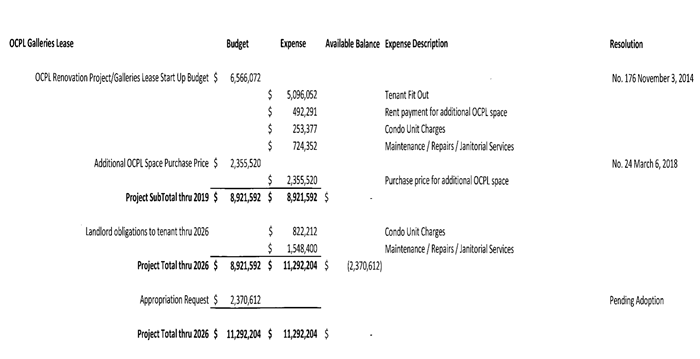
In answer to Ms. Kuhn, Mr. Morgan confirmed that he was referring to the Central Library located at the Galleries.
- Tenant fit-out roughly 60,000 square feet - 4th and 5th floor of the Galleries; project also paid the rent to the Galleries for floors 1, 2 and the basement
- Maintenance/Repairs/Janitorial Services for leased space on floors 4 and 5
-
All items funded via current and future rent payments from SUNY Upstate
-
Additional funds were added to the project in March 2018, original resolution requested $4.3 million, legislature reduced the amount to $2,355,520 - the amount needed to buy the space leased for the library on floors 1,2 and the basement; after a lot of deliberation the resolution passed and we own that library space - cost analysis supported purchase over leasing
-
Project out of money; request $2.37 million strictly for managing the lease with SUNY Upstate – need to continue to support all landlord cost incurred
-
Funds will again be funded with current and future rent payments from SUNY Upstate; not asking for tax dollars at this point, project will balance out in the future
- Project has many moving parts, can be confusing for those not around when it happened
Chair Cody said that Ms. Kuhn was not here and asked if Mr. Bush recalled the back and forth on this. Mr. Bush answered that some of this was before his time.
Mr. Bush said that the entire scenario has been really convoluted and asked if Mr. Morgan had any idea how much the taxpayers invested in that building. Mr. Morgan responded that taxpayers were not asked for tax dollars to renovate the space, aside from up fronting dollars to get these things done. At the end of the day, the rent from SUNY Upstate will pay all costs associated with the renovation. Mr. Bush asked the total costs from the start of the project. Mr. Morgan responded that the detail expenses for the project are in the handout as reviewed.
Mr. Bush asked if there was any way to break out the library portion of costs versus the rental from Upstate. Mr. Morgan responded that it is the $2.3 used for the purchase and the rent paid for space on floors 1, 2 and the basement.
In answer to Ms. Kuhn, Mr. Morgan said that tenant fit-out costs were for floors 4 and 5 and relate to the Upstate lease.
Ms. Kuhn asked where the income was. Mr. Morgan responded that this was just the expenditure side of the project. All the revenue comes from the lease of the space to SUNY Upstate; about $746,000 per year. It will take time for this project to balance out because of the large costs associated with the tenant fit-out and purchasing the space for the library. This requested amendment to the budget is estimated to get us through the initial 10-year term of the lease, which is 2026. Around that time they will be back to evaluate where they are at with the project and leasing that space.
In answer to Mr. Bush, Mr. Morgan said that the first 10-year lease will be up in 2026 and then there are two 5-year options. Upon getting closer to that time they will be back looking for support to continue that relationship or a new relationship.
Chairman Knapp said that he thinks Mr. Bush was looking for the cost to build out space for the library to move down in the Galleries. Mr. Morgan said that he could get that information but those costs were not part of this but. There was a bond resolution for about $7 million, which was the costs for the renovations for the library space, and some cash and grants were used. Ms. Kuhn asked when this took place. Chairman Knapp responded that it was about 5 or 6 years ago. Mr. Morgan said that if he is not mistaken the work was done in 2017-2018.
In answer to Mr. Bush, Mr. Morgan said that $2.37 million is the anticipated expense for the initial 10-year lease, ending 2026. Hopefully Upstate stays on for 2 additional 5-year terms. If not they will look to rent the space to another tenant.
Mr. Morgan said that this resolution amends the budget for the project and allows them to continue to manage the lease with SUNY Upstate. Chair Cody said that it is basically for landlord responsibilities associated with the lease. Mr. Morgan agreed and said that it is a little odd that it is in a project but that is how it was established. The overall financing plan for occupying space not previously occupied in the Galleries was to renovate and rent floors 4 and 5. It will take time to bring those rents in to balance out this project but in the end, there should be no local dollars spent for gaining additional space for the library and outfitting the floors for lease to SUNY.
Mr. Bush said that he feels uncomfortable in the timeline being requested. Rent and expenses will occur each year and he questioned if they would be reporting to the legislature on any of that. Mr. Morgan responded that they would report if the legislature so requested. As mentioned, they will be back towards the end of the first 10 years of the lease because they will probably have to request additional funding for this project and/or request a new lease. Mr. Bush said that it makes him nervous to hear they will be coming back for more funds. Chair Cody said that when the lease is up it will have to come back. Mr. Bush said that he understands that part. Chair Cody said that they could request an update for a year from now if desired.
Ms. Kuhn said that $746,000 multiplied by 6 additional years equals about $4.5 million. Mr. Morgan responded that the upfront expenses incurred have to be funded. Ms. Kuhn said that she thought that was taken care of. Mr. Morgan responded that it is not taken care of. The project is negative and will continue to be negative into the future as it will take time to balance out.
Ms. Kuhn said that the expenses and budget appear to be balanced. Mr. Morgan responded that the balance is just from an expenditure standpoint. Ms. Kuhn said that she does not have the revenue side of the equation therefore she thought the revenue was $746,000 and that is why she did the multiplication. Mr. Morgan said that it is but if you consider the years they have been leasing the space it falls far short of the $8.9 million expense. After the 10-year lease, the project will still be upside down by $3 to $3.5 million. After that, it will take another 8 to 10 years to get the project balanced.
Ms. Kuhn said that there will be a lot of additional maintenance and repairs by then. Mr. Morgan responded that this is why he mentioned that they will be back around 2026 to reevaluate this project and hopefully have a conversation about who will be leasing this space.
Ms. Kuhn asked if they were confident that $2.3 million would take care of the expenses for 6 years. Mr. Morgan responded that this was their estimate; will be back before 2026 to ask for additional appropriation and revenues if it doesn’t.
Ms. Kuhn said that it seems like this has to happen. Mr. Morgan responded that this is their landlord responsibility. Ms. Kuhn said that it is a tough spot to be in when they weren’t involved in the initial transaction. Mr. Morgan responded that it is a creative financing plan. They can criticize it for tapping into future revenues but it was a way to get the space needed for the library and the tenant fit-out costs without asking for taxpayer dollars. Mr. Bush said that they were kicking it down the road.
A motion was made by Ms. Kuhn, seconded by Chair Cody, to approve this item. Passed unanimously; MOTION CARRIED.
Mr. Bush said that he is going with this but it is horrible financing. Mr. Morgan responded that it was an approach to get 30,000 square feet in the Galleries without asking for local property tax dollars. Mr. Bush said that being upside down doesn’t make him feel comfortable. Mr. Morgan said that a lot of projects are upside down at some point. Chairman Knapp said that this has been a resounding success. The library moved down to the first floor and it is beautiful. The things they do there are incredible and that end of town is seeing a resurgence. Between the Allen building, the library and the Hotel Syracuse everything is going in the right direction and this is what they did to avoid tapping into local dollars.
In answer to Ms. Kuhn, Mr. Morgan said that this is not local dollars, it is current and future revenues for leasing the space.
Mr. Bush noted that the library director was present. Mr. Christian Zabriskie introduced himself and said that the library shares use of this space, needs their help and appreciates their support. Chair Cody thanked Mr. Zabriskie for attending.
2. TRANSPORTATION: Marty Voss, Commissioner
a. Authorizing an Intermunicipal Agreement with Oswego County for Bridge Repairs Associated with the Caughdenoy Road Bridge over the Oneida River ($650,000)
Mr. Voss:
-
Bridge jointly owned with Oswego County, located in the Town of Clay, 14th legislative district
-
Project concept started in 2017, funded in 2018 work plan, moving toward 2020 construction – project to start as soon as the IMA is signed
-
Total estimate $1.3 million for repairs and bridge reconstruction, don’t believe it will get that high; 50/50 cost split between Oswego and Onondaga Counties, not to exceed $650,000 each
-
Worked with Oswego County Legislature to find IMA for the same bridge in 1997, used as a baseline to create this IMA
In answer to Chair Cody, Mr. Voss confirmed that this bridge is where you cross into Oswego County in the Town of Hastings.
In response to Chairman Knapp, Mr. Voss said that Onondaga County will handle the bidding and hire the company. Chairman Knapp said that we will be the project lead. Mr. Voss responded that it is just a cleaner way to do it. Chairman Knapp said that Oswego will then pay us for their share.
Mr. Voss said that he will be back next month for the work plan.
A motion was made by Mr. Bush, seconded by Ms. Kuhn, to approve this item. Passed unanimously; MOTION CARRIED.
Chair Cody adjourned the meeting at 10:54 A.M.
Respectfully submitted,

KATHERINE M. FRENCH, Deputy Clerk
Onondaga County Legislature
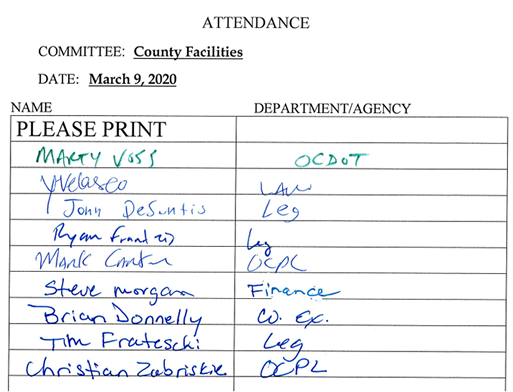
* * *
PUBLIC SAFETY COMMITTEE MINUTES – MARCH 9, 2020
CHRISTOPHER J. RYAN, CHAIRMAN
MEMBERS PRESENT: Mr. Rowley, Ms. Kuhn, Mr. Holmquist, Mr. McBride
ALSO ATTENDING: Chairman Knapp; See attached list
Chairman Ryan called the meeting to order at 12:03 p.m. A motion was made by Mr. Rowley, seconded by Ms. Kuhn to waive the reading and approve the minutes of the previous committee meeting. Passed unanimously; MOTION CARRIED.
1. SHERIFF’S DEPARTMENT: Sheriff Eugene Conway
a. Amending the 2020 County Budget to Make Funds Available for Use by the Sheriff’s Office Within its STOP Violence Account ($249,989)
- Originated with Superintendent of Onondaga Central, Rob Price; law enforcement agency required to be partner for grant; welcome opportunity
-
Grant will cover 7 districts, total of 21 schools; grant primarily provides training to school personnel and students; training coordinated through Boces and Cornell University
-
Grant length can be upwards of 5 years to get all parties trained; Sheriff’s Office important part of Onondaga County School Safety Task Force – this will help task force get training in hands of school personnel and students
-
Grant does not provide equipment (i.e. locks for school); it is for assessments on mental health; expertise given to Cornell University, coordinated through OCM Boces
-
Grant will build on current efforts to enhance violence prevention and improve ability to respond to related mental health crisis; talk about violent behavior in schools; creation of multi-disciplinary program for school staff and teachers
- This is not for treatment; lead to better assessment of students who may have propensity to be violent in schools
Sheriff Conway stated he can provide the committee with the full description of the narrative. Chairman Ryan said that would be great.
Sheriff Conway responded to Chairman Ryan that all the schools are in Onondaga County. Chairman Ryan asked how schools sign on and benefit, and Sheriff Conway responded that Superintendent Price would be the one to answer that. The grant writer is from OCM Boces. Cornell University’s connection is a Therapeutic Crisis Intervention for Schools Training of Trainers. Sheriff Conway agreed with Ms. Kuhn that the money is going to training trainers and school personnel. No match is required by the County. Ms. Kuhn asked if it’s funneled through the Sheriff’s Office. Sheriff Conway explained that they have reporting requirements, are part of the team that coordinates personnel and training, and will provide input as the law enforcement agency.
Mr. Rowley asked if the grant is reimbursable, or if funding is up front, and Sheriff Conway responded that he is unsure, but believes it is not reimbursable.
Sheriff Conway confirmed for Ms. Kuhn that Superintendent Price is with Onondaga Central Schools.
A motion was made by Mr. Holmquist, seconded by Mr. McBride, to approve this item. Passed unanimously; MOTION CARRIED.
b. INFORMATIONAL: Grant Funded Vehicles
Chairman Ryan stated this is regarding a request for the Sheriff’s Office to purchase 20 vehicles.
Chairman Ryan asked what is normally funded using the telephone account and Stop DWI. Sheriff Conway replied:
-
Telephone account is generated from revenue of inmates using telephone services; percentage comes back to Sheriff’s Office; some discretion on how funds utilized
-
Also commissary account for Custody and Corrections - derived from inmates who purchase things of commissary nature; through agreements with vendors, Sheriff’s receives a percentage of revenue
-
Both are regulated by Commission on Corrections as to what the funds can be utilized for
-
Stop DWI – Sheriff’s receives percentage of fine money from DWI’s; DA also receives money based on DWI arrests
-
Program in existence for many years; money goes to separate account to use towards things that speak to DWI including (i.e.) enforcement, prevention and education; coordinated through Mr. Barry Weis
Ms. Kuhn asked if any of the funds go back to inmate needs. Sheriff Conway responded that Stop DWI funds are not connected, but the telephone account is. It is used for Inmate Welfare Rehabilitation based on guidelines.
Sheriff Conway responded to Mr. Rowley that they are using some of the telephone account for vehicles; commissary would not be allowed. Mr. Rowley asked what the BOMB Squad Initiative Grant is that is being used for a vehicle. Sheriff Conway answered that they apply for multiple grants and are usually successful getting some funds. The grants have to be used in ways related to the grants purpose, and this grant would include (i.e.) training or vehicles. As part of the grant authorization, the Sheriff’s Office has to provide services to not only Onondaga County, but throughout Central New York. Mr. Rowley has not heard of the SCAAP (State Criminal Alien Assistance Program) grant. Sheriff Conway explained that those funds come through Custody, and it is a statewide grant that all Sheriff’s Offices receive. It is usually around $20,000 - $40,000 done with a special formula that is calculated and automatic every year.
Mr. Rowley said the funding for the vehicles is roughly $565,000 and asked if all of the funds have been encumbered in the various accounts. Sheriff Conway replied yes. Mr. Rowley said they received information on revenue and expenditures year by year, but it does not show the balances on these accounts. What are the balances after the encumbrances for the Custody and Corrections telephone accounts? Sheriff Conway responded that he does not have that in front of him, but they do have tracking on the balances. Mr. Rowley requested the balances on all the accounts after the encumbrances for the vehicles. If they are using funds now, then it would be nice to know what is left for future use for vehicles. Sheriff Conway explained that there are guidelines for the accounts.
Mr. Rowley said the Legislature authorized $325,000 for vehicles and asked if those vehicles have been bought. Sheriff Conway replied:
-
That amount comes to 9.5 vehicles; feel strongly that it is not sufficient; department has had a Vehicle Fleet Replacement Plan since he began his administration
-
Patrol vehicles unique - cannot buy on lot or order; there are only certain dates manufacturer makes the police patrol vehicles; build date, start date and end date – if miss the date, the manufacturer does not build more; wait for next year
-
Have to abide by the dates; vendor does not care about budget cycle; have to be conscious of when dates are to get order in, otherwise miss for the year; biggest concern with patrol vehicles, which were most of request for 2020
-
All replacement vehicles; not increasing size of fleet
-
Order for the 9.5 vehicles has been placed – not ordering 29 vehicles
-
Original request was 23 vehicles; forecasted out for 2-3 years; total dollars originally requested was $800,000
-
Additionally there are vehicles involved in accidents – 3 with extensive damage and totaled; all happened since budget; none were deputy’s fault
-
When vehicle totaled and money recovered, the money goes to the general fund; lost not only 3 vehicles, but the funding to replace them; do not understand the rationale
Mr. Rowley stated he does not understand that either, as they should be getting the recovery money to replace the vehicles. Ms. Kuhn asked if this is the way it has always been, and Sheriff Conway said yes.
Chairman Ryan said there are Ford Interceptors and a pickup for Jamesville. Is the pickup for maintenance? Sheriff Conway responded yes; salting and plowing facility.
Sheriff Conway confirmed for Chairman Ryan that there are 7 total Ford Fusions for CID and Internal Affairs. Chairman Ryan asked if there is a difference between CID and Internal Affairs, and Sheriff Conway answered no really. It is non-emergency work, and they buy the Ford Fusion off the state contract. CID vehicles are take-home, which is contractual. Internal Affairs also has take-home, since they are called in at all hours of the day and night.
Mr. Rowley asked if the Sheriff’s Office receives money from vehicles that are taken to auction, and Sheriff Conway said no. Ms. Kuhn asked how that gets corrected. Mr. Rowley said, from his perspective, the funds should be recognized in the Sheriff’s revenue, and they should do a budget amendment to appropriate the revenue to be used for replacement vehicles. If they auction 20, they may have enough funds for 1 or 2 new.
Mr. Holmquist stated:
Sheriff Conway commented that he will provide all information they request, and he would like this to be an understood subject as much as possible. It is an annual subject. Chairman Ryan stated that this is a good point by Legislator Holmquist. The chair of VURB is here, and Chairman Ryan is also a member. There has been digression of what VURB should be, and what comes in front of them. If there is a vehicle in an accident, the committee does not want the department to be short.
Chairman Knapp stated that Legislator Holmquist nailed it with communication, and he applauds Sheriff Conway for finding the money for the vehicles. $560,000 for 20 vehicles is a major purchase, so some kind of communication with the committee, or Chairman, sharing the information would be appreciated. Instead, this came down to VURB on Tuesday or Wednesday, and the deal would be lost if it was not done by Friday. The Legislature would like time to digest it, even though it is a good surprise seeing that they are purchasing 20 vehicles that tax payers are not paying for directly.
Sheriff Conway cannot in good conscious accept 9.5 vehicles, when he knows they will come back again in two years to ask for 50 vehicles. This is why there is a Vehicle Replacement Plan. Unless something changes in requests and what is granted, Sheriff’s will be back next year purchasing vehicles through discretionary funding. Ms. Kuhn asked why it was last minute, and Sheriff Conway responded that it goes back to deadlines and submitting orders for the patrol vehicles. Sheriff Conway explained that they do not know what the budget will be until November, and they cannot spend 2020 money until January 1st. They have to get ahead of the curve, but are barred by how the process is. Plus they are acting on the manufacturers deadlines.
Chairman Ryan requested a copy of the most updated Vehicle Replacement Plan. Sheriff Conway agreed and said it goes out to 2022. 2021 request is 25 vehicles, and 2022 is 24 vehicles; most being patrol vehicles.
Mr. Holmquist asked if there is anything automatic with a department losing vehicles in collisions, and Sheriff Conway replied there has never been anything in place. Mr. Holmquist asked if that is a possibility and would this help. The Legislature knows there will be car crashes, so maybe put money into contingency. Sheriff Conway explained that it’s not a timeliness issue, but a revenue issue. It would be better to have the revenue go into the vehicle line for the next year. Always able to manage with fewer vehicles until the next year replacement. Two of the three patrol vehicles totaled were parked at the same scene, and a truck took them out. The third was a deputy going through an intersection, and they were hit by a DWI person. The revenue from those insurance claims should go to the Sheriff. Mr. Rowley stated that the revenue is budgeted for in a miscellaneous revenue line, but it is not pegged to vehicles. There is a guess as to how many vehicles are sold or totaled, and it is used to balance the budget. Chairman Ryan said if the money is put into a miscellaneous line, then it can be appropriated to vehicles. Mr. Rowley said it is already spoken for in the Sheriff’s budget. They have to think outside the box to figure out how to handle vehicles when they’re taken out via accidents.
Chairman Ryan requested an updated list of take home vehicles.
2. INFORMATIONAL: Cancer Prescreening for Firefighters
Chairman Ryan:
- Working on it with President for NYS Firefighters Cancer Foundation
-
Something the committee should advance; moving beyond concept and working with legal to complete stipulations for what they define screening as; if not county employees (very few are), how do they fund and reimburse
-
Firefighters at 100% greater risk of being diagnosed with lung cancer over general population; if diagnosed at stage 1, then survival rate exceeds 90% - if they can control this at early stages, that would be great
Ms. Kuhn commented that her father was a New York City firefighter who died of lung cancer, and it was directly related to a fire he was in. There was no screening back then, so this is very important. Chairman Ryan said the New York City Firefighter Cancer Foundation does a lot of work and raises a lot of money.
A motion was made by Ms. Kuhn, seconded by Mr. McBride, to adjourn the meeting. Passed unanimously; MOTION CARRIED.
The meeting was adjourned at 12:46 p.m.
Respectfully submitted,

JAMIE McNAMARA, Assistant Clerk
Onondaga County Legislature
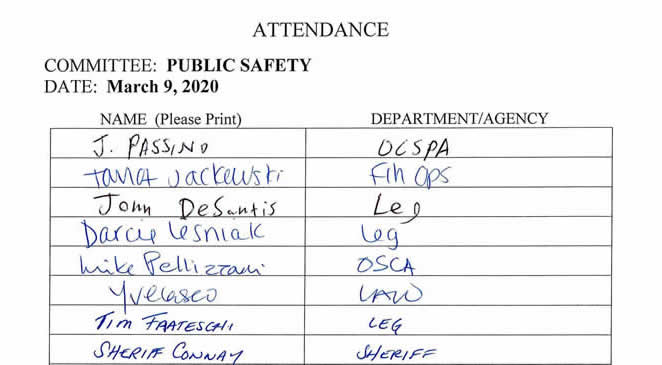
* * *
PLANNING & ECONOMIC DEVELOPMENT COMMITTEE MINUTES – MARCH 11, 2020
KEVIN A. HOLMQUIST, CHAIRMAN
MINUTES
* * *
HEALTH & HUMAN SERVICES COMMITTEE MINUTES – MARCH 11, 2020
JULIE ABBOTT-KENAN, CHAIR
MEMBERS PRESENT: Dr. Chase, Mr. Bush, Mr. Kinne
MEMBERS ABSENT: Ms. Cody
ALSO ATTENDING: Chairman Knapp, Ms. Kuhn, Mr. Jordan; See attached list
Chair Abbott-Kenan called the meeting to order at 10:38 a.m. A motion was made by Dr. Chase, seconded by Mr. Bush to waive the reading and approve the minutes of the previous committee meeting. Passed unanimously; MOTION CARRIED.
1. COMMUNITY SERVICES ADVISORY BOARD:
a. Confirming Reappointments to the Onondaga County Community Services Advisory Board (Indu Gupta M.D, Jennifer Redmond, Monika Taylor)
A motion was made by Mr. Kinne, seconded by Dr. Chase, to approve this item. Passed unanimously; MOTION CARRIED.
2. VETERANS SERVICE AGENCY:
a. A Local Law Amending the Onondaga County Charter and Administrative Code Regarding Veterans’ Services
b. Providing for Various Personnel Changes Related to the Reorganization of Adult Services and Amending the 2020 County Budget
A motion was made by Mr. Bush, seconded by Dr. Chase, to approve items 2a and 2b. Passed unanimously; MOTION CARRIED.
3. SOCIAL SERVICES – ECONOMIC SECURITY: Sarah Merrick, Commissioner
a. INFORMATIONAL: Medicaid
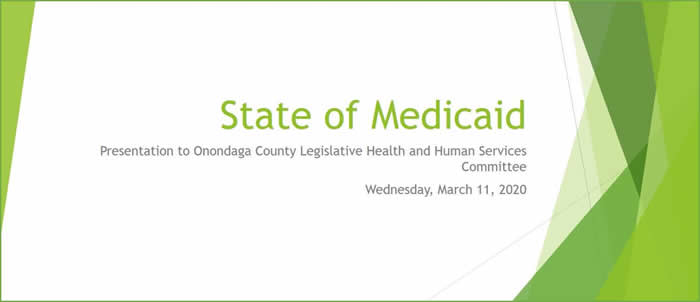
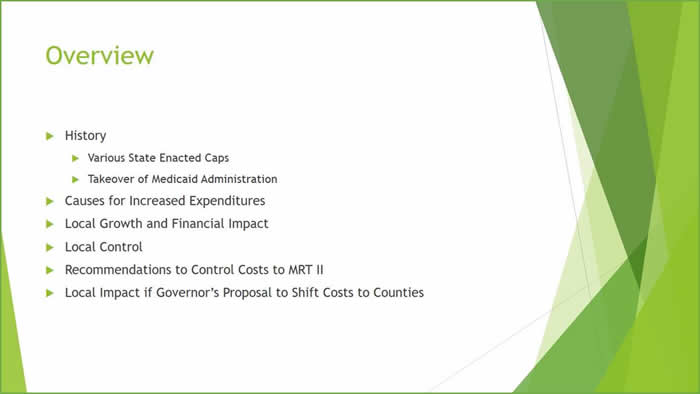
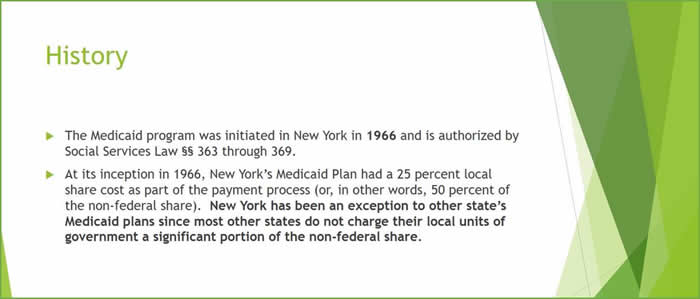
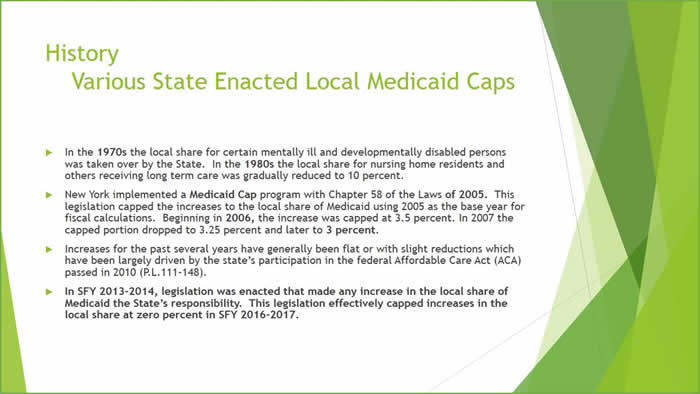
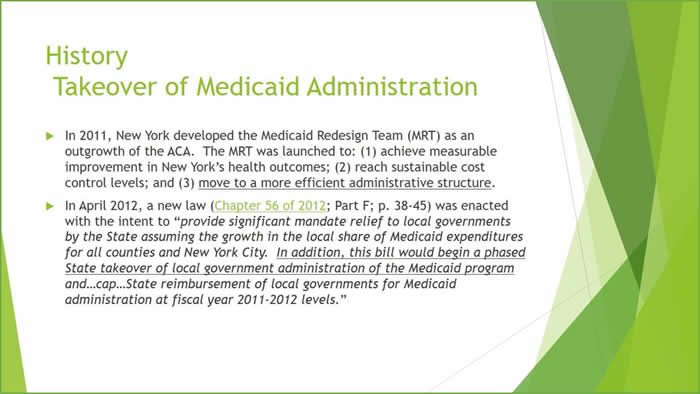
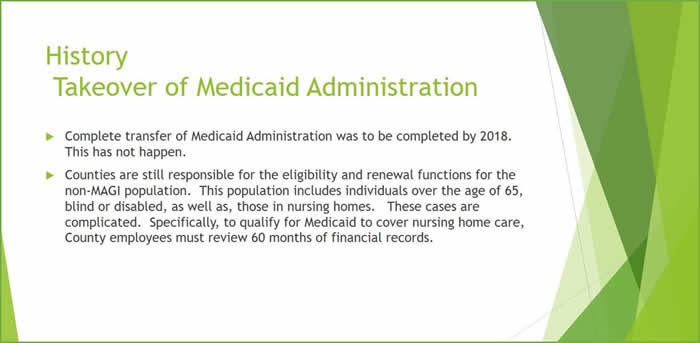
Ms. Merrick stated that they still take care of 40% of the work. The state was supposed to completely take over the work by 2018, but that has not happened. The department is handling the work for the hardest cases, including going through all financial records (i.e. bank records, investment portfolios, trusts) to ensure the person did not pass off their investments to friends or family members. This disqualifies them (for a period of time) from eligibility for Medicaid.
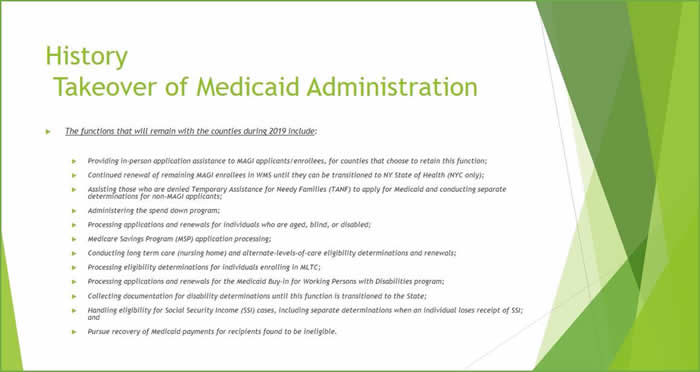

- $2 Billion of the increased costs of Medicaid are due to the minimum wage increase alone
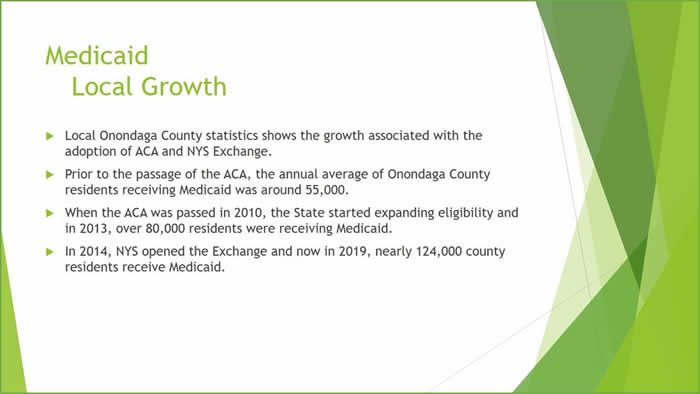
- NYS exchange handles 60% of cases; County handles 40% of the cases
- Cases went from 55,000 to 124,000 in 2019; cannot have that jump and expect costs to stay flat and not increase

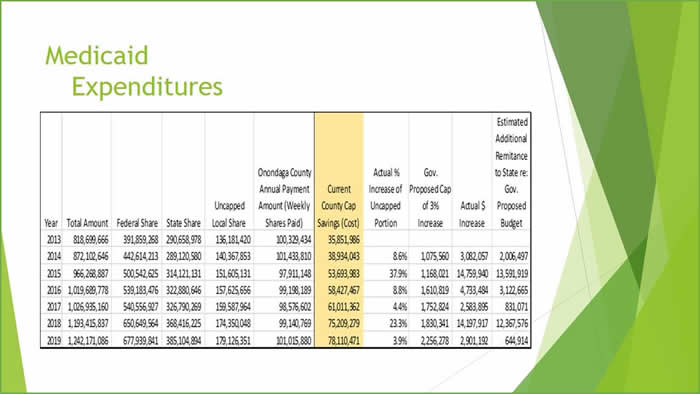
- Chart is Onondaga County alone – 2021 Governor budget best guestimate numbers
-
Governor says the County needs to keep growth at or under 3%, but there is no year below 3%; state has said the annual growth is at 5.5%; in budget, it says local growth has to stay under 3%, or there will be penalties
-
Last column is guestimate of what would happen; language in the budget is very convoluted; many attempts by NYSAC to get straight language on how to run the numbers
-
2015 and 2018 numbers are where the growth started; ACA picked up steam with people applying; numbers are as good as what state provides; ebbs and flows; but rapid increase is the expansion of ACA

-
County does not have its own rules; follow state and federal rules – department is audited all the time; if they vary from laws and policies, then run risk of financial penalties
-
Lot of misinformation about controlling spending – County does not control, or set, eligibility standards
-
State and federal government controls the eligibility standards; Medicaid falls under the NYS Department of Health; package is presented to state Legislature, who has control over the package of services, which the state administers
- State Legislature voted and accepted expansion of the Affordable Care Act (ACA)
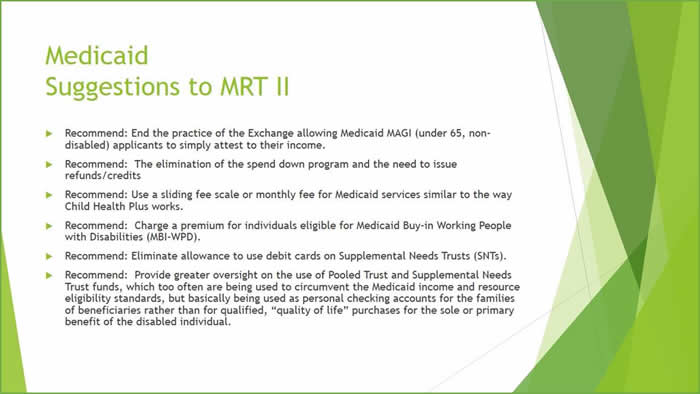
Chair Abbott-Kenan asked how many cases are sent in for fraud. Ms. Merrick responded that it is nowhere close to what it used to be, but she will get a number.
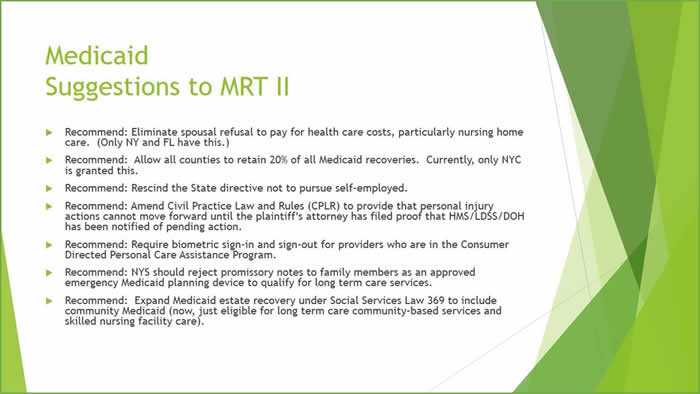

- How are county governments going to generate funding for the increased costs of Medicaid being passing to local level
- If pass 2% cap, then financially penalized; have to keep increase to 3% (no control, state says increase at 5.5%)
- Range based on NYSAC calculator - $2 million to $12 million; best guestimate based on language
Chairman Knapp said Ms. Ann Rooney and Ms. Sarah Merrick are doing a great job navigating this process. Several years ago, the state made a deal with the County to impose a property tax cap in exchange for taking over the growth of Medicaid. It has worked for the past several years, and the County has not only stayed below the 2% cap, but taxes have not been raised. The projected numbers would decimate the County, and any discretional spending would be out the door. New York City is looking at $1.1 billion, and Erie County may be under a financial control board because of it.
4. INFORMATIONAL: Coronavirus
Chair Abbott-Kenan discussed with Dr. Gupta about having a standing update on Coronavirus as long as there is a health crisis going on around the world.
Dr. Gupta:
-
COVID-19 (disease) - new strain resulting in new infections around the world; US latest numbers are 1,025 with 28 deaths; 173 in NYS, with most in Westchester County (108); expect something will happen everywhere
-
Focus on prevention - working with health care sector
-
Testing – identification of cases in terms of providing correct testing; work with them to make sure if someone tests positive and discharged, make sure they are taken care of
-
Role of Health Department – primarily surveillance, data collection and informing community of prevention strategies
-
No vaccine, no medication, antiviral for flu – best bet is each other, what we can do; do not underestimate power of people; put things in process at home, work and touch points in community
-
Parallel to flu; US – flu illness affects 39 - 40 million each year; medical visits range from 16 - 23 million; flu deaths estimated at 20,000 – 52,000
-
New virus – concerned, but do not panic; live lives and do everything to protect ourselves, families and community
-
Stay home when sick; if coughing, use mask; wash hands with soap and water, as well as sanitizer (60% alcohol)
-
If child sick, keep home; talk to employer if is sick
-
Working together with health system - outpatient primary care, senior living, schools, etc.
-
County Executive Ryan McMahon, Deputy County Executive Ann Rooney and Commissioner Dan Wears (Emergency Management) meet every day to go through things; talking to community in large
-
Important to have information; if things change; will inform public in timely manner
- Emphasizing personal protection
Chair Abbott-Kenan commented that she appreciates the daily updates and staying ahead of things. Dr. Gupta said there is something everyone can do, and they should not feel paralyzed. The problem is here in the US and Westchester County. What can we do to mitigate? What is in our hands? Talk to children, parents and grandparents. Dr. Gupta said they have to work together and continue getting information from the right sources. The Center for Disease Control (CDC) website is a great resource. Learn about the importance of a future vaccine, because vaccination saves lives. There will be no vaccine for a year and a half, and there are no antiviral medications. The many diagnoses are good to know what is happening in each community, and what they can do to prevent it in the future.
Mr. Bush requested to be added to the mass emails of information. Mr. Wears said they did add a few Legislators, and they will expand on that. Ms. Rooney asked everyone to sign up for the OnAlert system, which provides instant messaging. Mr. Bush said it will be helpful to pass on information to constituents.
Mr. Bush asked what the main difference is between this and the traditional flu. Dr. Gupta responded:
- Very new virus; belongs to family called Coronavirus, which is common cold virus
-
COVID 19 virus - jumped from animal to human; started in China; when virus jumps from one species to another, it changes character and becomes stronger with new host; this creates more symptoms and more severity
-
It attacks different age groups - mostly older folks, same as flu; flu varies with affecting young people
-
Will it be seasonal? Will it go away with the warmer season? Will it come back in fall?
-
Best thing to mitigate it; prevent transmission of virus – staying 6’ away to talk to someone with protective gear
-
Transmitted with droplets – coughing or sneezing, touching a surface, then touching face
- Learning how it will behave – concern what will happen; as well as treatment and vaccination strategies
Chairman Knapp said thank you for coming, and said the level of communication has been outstanding. The big message is that the County needs to speak in one voice. If someone is feeling sick, they need to call their doctor; not go to the Emergency Room. If they go to the ER, they will infect everyone there. People need to call their doctor, and they will know what steps to take.
Ms. Rooney commented that they are working day and night to make sure hospitals are not overrun when people have a heart attack, broken leg or car crash. The results indicate that many more people will go to the hospitals. Potential social distancing is to help maintain the health system. Past pandemics show people who could not get through the health system for typical things not related to the pandemic.
Chairman Knapp asked if China reached a peak, and Dr. Gupta responded that it is hard to tell. It could go on for quite some time. Dr. Gupta reinforced the point Chairman Knapp made that if someone is sick, they need to call their doctor. They will do phone triage, so the doctors are not overrun.
Dr. Gupta replied to Mr. Kinne that Germany has quite a bit of cases, and they are currently higher than the US. To see the cases around the world, go to gisanddata. Right now there are 121,000 confirmed cases, 4,300 deaths, and Germany is at 1,050 cases. The majority of deaths in the US were at the Seattle nursing home. Information is also available on the CDC website and http://www.ongov.net/health/coronavirus.html. The Onondaga County Health website has a Coronavirus button, and within that page are active links for how to take action. It is important to stay informed and be engaged in protecting each other, family and the community. NYS Department of Health has a 1-888 number, and there is a lot of information regarding the NYS cases.
Mr. Bush wanted to know what happens if a person does not have a primary care provider. Dr. Gupta explained that most of these people are going to the emergency room. Onondaga County has a high rate of insured, so a majority will go to their primary care doctor. Dr. Gupta said they are trying to come up with ways to deal with these situations, and to help guide people. The testing is very streamlined, but it’s not for those feeling fine. There are criteria on the NYS website.
Ms. Kuhn asked what the County is doing for the homeless population. Ms. Rooney answered that they are working with Human Services leadership consult to make sure the information is getting out to them. There are also posters being provided, and the best places to post them is in public restrooms.
Mr. Bush stated that he would like a representative from Vera House to come and speak to the committee about what they are doing, their relationship with the County and funding. Chair Abbott-Kenan said she will reach out.
A motion was made by Mr. Bush, seconded by Dr. Chase, to adjourn the meeting. Passed unanimously; MOTION CARRIED.
The meeting was adjourned at 11:25 a.m.
Respectfully submitted,

JAMIE McNAMARA, Assistant Clerk
Onondaga County Legislature

* * *
ENVIRONMENTAL PROTECTION COMMITTEE MINUTES – MARCH 11, 2020
CASEY E. JORDAN, CHAIR
MEMBERS PRESENT: Mr. Holmquist, *Mrs. Abbott-Kenan, Dr. Chase
MEMBERS ABSENT: Mrs. Tassone
ALSO ATTENDING: Chairman Knapp, Mr. Bush, Ms. Kuhn; see attached list
Chairman Jordan called the meeting to order at 12:02 p.m. A motion was made by Dr. Chase, seconded by Mr. Holmquist, to waive the reading of the proceedings from the previous committee. MOTION CARRIED. A motion was made by Mrs. Abbott-Kenan, seconded by Dr. Chase, to approve the minutes of the previous committee meeting. MOTION CARRIED.
1. ONONDAGA COUNTY SOIL AND WATER CONSERVATION DISTRICT:
a. Confirming Reappointments to the Onondaga County Soil and Water Conservation District Board (Craig S. Dennis, John Lemondes, David Coburn)
A motion was made by Mrs. Abbott-Kenan, seconded by Dr. Chase, to approve this item. Passed unanimously; MOTION CARRIED.
2. ENVIRONMENT, OFFICE OF: Travis Glazier, Director
a. A Local Law Amending the 2004 Stipulated Judgment Between Honeywell International Inc. (Honeywell) and the County, Authorizing the Lease of Two Parking Areas From Honeywell and Authorizing the Execution of Agreements
Mr. Glazier discussed items 2a, b and c simultaneously:
-
ACJ and CERCLA are separate cleanups for Onondaga Lake - CERCLA is also known as the superfund which is between Honeywell or its predecessor Allied Signal and the DEC
-
Allied Signal sued Onondaga County as a potentially responsible party (PRP), between 1995 and the early 2000s’ the county and Allied Signal were embroiled in litigation; that defense cost millions of dollars
-
Honeywell bought Allied Signal; in 2004 the county and Honeywell agreed to the Stimulated Judgment – a far-reaching and complicated document that settled all legal disputes between the county and Honeywell and protected the county from future lawsuits and saved the county tens of millions of dollars; still hold the county was never a PRP
-
That agreement has served the county well for 16 years and is still relevant today; language contains much ambiguity
-
Remedial use fees were used to incentivize Honeywell to get properties back into productive use within a reasonable period of time and to ensure the county had a seat at the table; had disagreements on every aspect of the meaning of remedial use fees sense the ink dried, everything from what constitutes achieving a point where fees are not applicable to which properties are not covered by the fees; complicated language
-
This resolution is the county’s attempt to resolve those conflicts; the stipulated judgment states that payments are due by the end of the year from Honeywell
-
The federally lodged document requires many approvals beyond the legislature
-
Local law (2a) allows the county to accept 40 acres of lakeshore property, enter into 2 lease agreements - one long-term with a minimum of 10-years and two 3-year extensions, and an additional year-to-year lease for up to 10-years, on two 20-acre lots in the Willis Ave. parking area
-
Budget resolution (2b) accepts $625,000 in the 2020 budget for Loop the Lake improvements
-
SEQRA approval for Type 1 action(2c), negative declaration for all these components
-
This agreement is for the last privately owned property around Onondaga Lake, located on the southwest shore, the lease is the Willis Ave. parking area which the county can use to offset parking at the amphitheater, or sell parking for events to generate revenue for the county, and a $625,000 payment; on the other side, this agreement extends the suspension period for the remedial use fees an additional 10-years for the remaining properties and clarifies the ambiguity within the agreement by establishing the qualifying uses and gets back to the original spirit of the agreement, which is to find common ground to advance the cleanup of Onondaga Lake
- Remedial use fees were never intended to be a revenue source for the county, was always intended to be a hook; nominal amounts compared to the cleanup and liabilities
Chairman Jordan said that the local law provides for the county to take title to several parcels that the environmental review references as contaminated pieces of property. The DEC could come back and the county would be responsible for future remediation or cleanup of these properties as nothing in the local law refers to Honeywell retaining financial obligation; questioned if he is missing something. Mr. Glazier responded that 5 parcels make up the lakeshore property. Those properties established remedial action objectives (RAOs) which set forth that those properties be remediated to a state where they will be acceptable for commercial park usage. The properties have achieved the RAOs set forth and there is a Record of Decision (ROD) on the site. The site is being used as intended. Regarding long-term obligations, the consent orders that exist between Honeywell and DEC remains in place. In no way are we indemnifying Honeywell of any of its obligations. Similar to the western shore trail and amphitheater sites which are Honeywell remediation sites that the county owns but Honeywell retains all responsibility for dealing with their cleanup. Honeywell will maintain all operations and maintenance on the remedies themselves and retain responsibility for any releases or failures within the cleanups themselves under the consent orders. The county is also indemnified within the stipulated judgment itself from lawsuits against Honeywell.
Chairman Jordan asked to be provided with the documentation that substantiates Honeywell is retaining liability for any future remediation or cleanups needed on the property. Mr. Glazier responded that the information can be sent.
Dr. Chase said that this conversation is not new for this property. About 2 years ago they were advised to stay away from it because of the liability issues; if county-owned, could not guarantee that the county wouldn’t be responsible if there were some issues. It doesn’t seem as if anything is anything is different. Mr. Glazier responded that he did not recall what she was talking about. The county retains some responsibility under the NRD for an easement, which they retain no matter what. About what has changed, the ROD for this site came about over the summer of 2019 and it is the final step in the remedial process. It establishes what the final cleanup is and Honeywell has or is completing all the steps. In answer to Dr. Chase, Mr. Glazier confirmed that Honeywell will forever be responsible for any releases associated with the site under the consent order.
Chairman Jordan said that this is contrary to normal property law and he will need something more concrete to substantiate that Honeywell will remain liable for any causes of action that arise out of the use of the property or future remediation or clean up needed. Mr. Glazier responded that normally when there is a property transfer from PRP to a third party they clarify that issue. In this case, the stipulated judgment acts as the backstop against that. The judgment itself states that Honeywell is responsible for any actions taken against the county associated with their cleanup. Mr. Yaus said that we have already agreed to an easement on these parcels for the West Shore Trail so we will have an ownership interest on these parcels regardless of this transaction. The stipulated judgment is key – Honeywell released all claims against the county for these parcels. Honeywell is and will remain responsible and there are third-party indemnifications that go along with that. Honeywell also signed orders in which they affirmed their responsibility for these sites with the DEC. Like the amphitheater, our purchase agreement itself will say that we are not taking any liability. The final step will be to amend the court document in which Honeywell concedes they need ongoing access for their permanent and long-term maintenance. There is a plethora of protection. Honeywell understands, per agreements and conversations, that they will always remain responsible for remedial actions of the site.
Dr. Chase questioned if the plan was just to put the trail through the site. Mr. Glazier responded that the trail has already been completed. Ms. Primo responded that a master plan will be developed to determine how to use these lands; maybe parks and a mixture, not sure yet.
Chairman Jordan asked to be provided with the lease agreement for parking.
Mr. Bush questioned what happens if Honeywell goes bankrupt. Mr. Glazier responded that the assurances under each consent order establish Honeywell’s allowances for showing their ability to meet their commitments, which is between the DEC and Honeywell. Honeywell’s last prospectus showed 20 million dollars’ worth of revenue, which the DEC accepts in place of some sort of legacy account. Mr. Bush said the DEC accepts the financial responsibility if Honeywell goes belly-up; no bond is being put up. Mr. Glazier responded that this is a Superfund site and Superfund deals with sites that may have been abandoned. They take in a certain amount of money which is extra revenue used to clean up CERCLA sites that have since been abandoned. Also, the DEC and EPA are both on the hook when they establish an NPL site, which Onondaga Lake is.
Dr. Chase asked if they dealing differently with the parking lots. Chairman Jordan responded that the local law has everything all together. Mr. Yaus said that it is a package deal because it is a court document that governs what has to be provided to the court. Dr. Chase said that it is weird because they aren’t buying the land, just leasing it to park cars.
A motion was made by Mr. Holmquist, seconded by Mrs. Abbott-Kenan, to approve this item. AYES: 2 (Holmquist, Abbott-Kenan); NOES: 1 (Chase); ABSTENTIONS: 1 (Jordan). MOTION CARRIED.
b. Amending the 2020 County Budget to Accept Funds Related to Amendments to the 2004 Stipulated Judgment Between Honeywell International Inc. and the County ($625,000)
A motion was made by Mr. Holmquist, seconded by Mrs. Abbott-Kenan, to approve this item. AYES: 3 (Holmquist, Abbott-Kenan, Jordan); NOES: 1 (Chase). MOTION CARRIED.
c. Approving the Classification of a Type I Action Under the State Environmental Quality Review Act; Accepting the Environmental Assessment Form; and Accepting and Adopting the Negative Declaration for Proposed Amendments to the 2004 Stipulated Judgment Between the County and Honeywell International Inc.
A motion was made by Mrs. Abbott-Kenan, seconded by Mr. Holmquist, to approve this item. AYES: 3 (Holmquist, Abbott-Kenan, Chase); NOES: 0; ABSTENTIONS: 1 (Jordan). MOTION CARRIED.
3. WATER ENVIRONMENT PROTECTION: Frank Mento, P.E., Commissioner
a. Authorizing the Execution of an Order on Consent with the New York State Department of Environmental Conservation Relative to the Settlement of the Amended Consent Judgment
PULLED
b. A Resolution Approving the Proposed Leasing of Sewer Systems from Certain Municipalities within the Onondaga County Consolidated Sanitary District
Mr. Mento:
- Lease materially the same substance and format; still, a 40-year lease, 4 10-year continuous renewals with the landlord and tenant obligations remaining much the same
- 2 minor language adjustments:
- Section 3.2 (b) - municipalities may be eligible for up to $200,000 in debt relief after surplus is paid down, added an alternative provision intended to be supportive of municipalities without debt which states:
Alternatively, at Landlord’s election and in conjunction with a village main street or a town center or hamlet development project commenced within five (5) years of the Effective Date, Tenant may perform up to Two Hundred Thousand dollars ($200,000.00) worth of Onondaga County Department of Water Environment Protection (WEP) approved green infrastructure projects
2) Yesterday the EFC requested minor language changes relating to how these things are financed and paid for:
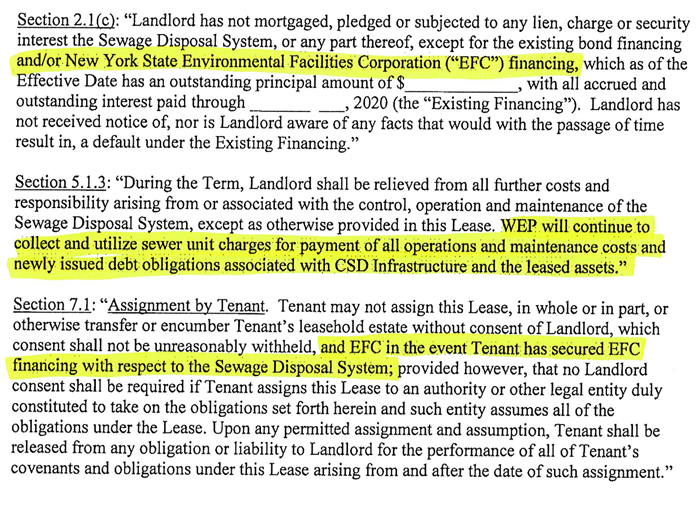
Mr. Yaus said that the language changes create a better position to maximize EFC financing by added clarity. They are simply factual statements.
Mr. Mento:
- The Meadowbrook-Limestone service area is Phase 1 of the program -
- WEP and county law had several meetings with the local municipalities and trustees in that area; currently have the Town of Manlius, the Village of Manlius and are very close to having the Village of Fayetteville onboard
- Towns of Dewitt and Pompey are next week; general acceptance within the community, hope it continues
- Want to move forward with this initiative in support of Meadowbrook-Limestone service area being under a consent order
Chairman Jordan said that within the City of Syracuse we have already spent $700 million under the ACJ; wasn’t some of that work on infrastructure owned by the city? Mr. Mento responded that work done under the ACJ was partially city and partially county infrastructure that was paid for by the entire consolidated district. The precedent has been somewhat set for helping out the city, which pays a higher percentage of the sanitary budget as they have a significant amount of users. The same thing is going to now apply to the towns and villages; those that contribute today will benefit in the future when their turn comes up.
Chairman Jordan asked how the work was performed on city infrastructure without a lease. Mr. Mento responded that it was all under a court order so things go differently. He was not part and parcel of the early stages of this but in general, the legal requirements obligated the county as the permit holder to make the necessary changes. That exact thought process goes with consolidations. They are responsible at the end of the pipe but sometimes aren’t responsible for what is in the middle or the beginning. The same principals will apply as they move forward with the towns and villages.
Chairman Jordan asked if there was any reason why they couldn’t do the same thing they did with the City of Syracuse in the Meadow-Brook Limestone District. Mr. Mento responded by asking if Chairman Jordan was saying he wanted to come under a consent order and federal oversight to handle these things. In general, they want to take proactive steps as a whole community to deal with stuff before DEC comes down with local permits to towns, charged back to the local municipality and not the entire district. Chairman Jordan said that he is not talking about the broader concept countywide; in this particular instance, could we do the same thing we did with the city and maybe deal with the idea of consolidating county-wide after the fact. He doesn’t think that this is a prerequisite for doing the work that needs to be done in the Meadowbrook-Limestone service area. Ms. Primo said that the DEC has only been comfortable with this approach because they see it as a definitive stand by the county to do what they have to do to address the I & I. Without doing this they are going to be required to make big and expensive improvements to Meadowbrook-Limestone.
Chairman Jordan said that they were comfortable enough with us working in the City of Syracuse, which is a more significant project. Ms. Primo interjected saying that she understands what Chairman Jordan is getting at. Law may have to explain this but what happened in the city was because of the combined sewers. That flow severely desegregated our streams and lake and they were not going to stand for it any longer. It was a very long process and, in the end, they were given the authority to make those changes on some city assets. Ms. Harty said that, from a technical standpoint, the ACJ looked at spot solutions for relieving the stormwater issues where consolidation was a comprehensive solution to the entire collection system. Rather than looking at major wet weather treatment facilities to handle stormwater the approach they are taking at Meadowbrook-Limestone is different in that they are going all the way from the lateral through the entire collection system and rehabilitating the infrastructure, which is very different from the approach taken in the City of Syracuse. The City of Syracuse did not rehabilitate the existing sewers. That is where she sees the difference and where DEC is supporting this approach because it is contiguous ownership under the county umbrella and the ACJ approach didn’t address continuous ownership.
Chairman Jordan said that he understands all that but it still seems like the county could effectuate the repairs that need to be done with an IMA. Discussions about consolidation of all the sewers within the county and the terms under which that would be done could continue along a parallel line. Mr. Mento responded that this would only happen by a legal decree which would put the county in a penalty and punitive situation and is going to cost more money over the long haul. Community-wide they are trying to nip this in the bud so that no one municipality, especially the villages that are very small in population and critical in terms of age, is forced to implement things that would put them out of business.
Chairman Jordan said that they keep going to a broader conversation. He is not happy with the terms of the lease but understands that there is an immediate problem in the Meadowbrook-Limestone area so why not make the improvements that need to be made and at the same time talk about the overall plan for sewer consolidation. Mr. Yaus responded that this is a priority area because of its impacts and DEC’s attention to it. That is why it is the first phase but consolidation is a broader principle for its own reasons. The Meadowbrook-Limestone's consent order discussions started before proposing a consolidation model. A $9 multi-million dollar I & & reduction program, funded by the county, according to the proposed consent decree was proposed and flatly rejected by the DEC. The DEC wanted very expensive facility upgrades and they were not able to agree until consolidation came into the picture. The point being they tired Chairman Jordan’s model, to begin with, and it was rejected by the DEC. Ms. Primo said that it is important to keep in mind that this model makes them very attractive to all sorts of funding. This will be a very expensive endeavor throughout the whole community. And, it will be more expensive if the county does it one way and the towns and villages then supplement it because they don’t have the expertise or volume discounts. A consolidated project will benefit from lower interest rates on EFC loans and all sorts of grant funding; another reason for taking this route.
Mr. Holmquist thanked Mr. Mento and his team for all the work they have done. He has had good discussions with the representatives from the Town Manlius and the Villages of Manlius and Fayetteville who are very appreciative of their presentations and outstanding professionalism. They are very excited about this because the consent judgment is hanging over the top of everyone. They appreciate how hard and complicated the problem is. Taking this approach is very attractive to everybody involved.
Ms. Kuhn asked if there was an overall plan for the consolidation. Mr. Mento responded that they have been working to nail down all the baseline components of this phase. The next phase will evolve within the next 6 months based upon need and other variables of impact, age, condition, etc. There was a need to really focus on this so that they could get everything right. In answer to Ms. Kuhn, Mr. Mento confirmed that there isn’t an overall plan at this moment.
Ms. Kuhn said that the city portion of Meadowbrook-Limestone is 47% of the problem, and asked where they stand. Mr. Mento responded that they are still in negotiations with the city for many reasons:
1) It is a combined system
2) The city wants us to take over their storm system; not part and parcel of the work that falls under our purview
3) The city has its own budget accounting for sewer hookups, revenues, and expenses; discussions continue but this won’t come to a quick conclusion
Ms. Kuhn said that it is an important part because they are the biggest piece of this. Mr. Mento responded that he understands.
Mr. Bush asked how it impacts the county if someone chooses not to participate. Mr. Mento responded that if the city chooses not to participate their rates will go up to reflect the unit rate for the entire district but they will still bear the brunt of having to deal with their own problems themselves.
In answer to Mr. Bush, Ms. Primo confirmed that this will still impact the consent order. They have talked with the DEC about looking at communities that do not cooperate directly and not looking to county to address the problem. It is going to be a problem for communities that refuse to address their I & I and also refuse to join in the consolidation effort.
Chairman Jordan said that they are saying this is an agreement to resolve the citation that was issued but it is contingent upon the effected municipalities all agreeing to participate. Ms. Primo responded that if there is a situation like they have with Meadowbrook-Limestone and they start doing work in these towns and there is a measurable reduction in I & I and they know they could get a further reduction if the city cooperated or did the work on their own, the DEC will go directly to the city and hold them responsible. Whether that happens in other communities depends on the situation they are faced with.
Mr. Bush asked if they have been able to breakdown who is contributing the greatest percent to cause the consent order. Mr. Yaus responded that they try. Mr. Bush said that they know where it is coming from but it has never been brought out publically. Mr. Mento responded that they have a pretty good indication. There are significant contributions across the entire district. The DEC looks at this at the treatment plant and they put everybody on notice that contributes to that plant. Mr. Bush said that if one municipality is contributing a significant amount to cause this consent order, he would think that they would be directed to clean up their act. Mr. Mento reiterated that this is currently not the way the DEC operates, they look at the treatment facility and the area that serves it.
In answer to Chairman Jordan, Mr. Mento said that effluent from Meadowbrook-Limestone goes into Limestone Creek. Mr. Yaus said that it is not part of the ACJ.
A motion was made by Dr. Chase, seconded by Mr. Holmquist, to approve this item. AYES: 3 (Holmquist, Abbott-Kenan, Chase); NOES: 0; ABSTENTIONS: 1 (Jordan). MOTION CARRIED.
c. A Local Law Authorizing the Lease of Sewage Disposal Systems from Certain Municipalities within the Onondaga County Consolidated Sanitary District for County Purposes
- Memorializes what was just discussed; local law needed because this extends beyond 5 years and references the tenants of the lease
A motion was made by Dr. Chase, seconded by Mr. Holmquist, to approve this item. AYES: 3 (Holmquist, Abbott-Kenan, Chase); NOES: 0; ABSTENTIONS: 1 (Jordan). MOTION CARRIED.
Mr. Mento thanked the committee for their consideration.
*Mrs. Abbott-Kenan left the meeting.
4. ONONDAGA COUNTY RESOURCE RECOVERY AGENCY: Dereth Glance, Executive Director
Ms. Glance addressed the agenda out of order:
b. Recycling 2020 Report
-
Critical National Sword policy came out of China a few years ago, recognized much of the material being imported was causing China significant amounts of pollution; saw big reduction years ago during the Beijing Olympics, the policy is now permanent
-
Over the last 15 years, 50% of the worlds recovered paper was sold to China; had significant costs to OCRRA
-
OCRRA is an enterprise fund so it is not funded by taxpayers, their revenues need to cover their expenses; revenues are primarily driven through garbage tip fees for at the Waste-to-Energy (WTE) plant, receive some revenue from electricity but the electricity markets have been falling year after year, now comprises less than 10% of their revenues, almost entirely dependent upon tip fees
-
For about 30 years OCRRA has subsidized haulers to collect source-separated materials as required by county law for a zero tip fee; if markets went up or down nobody experienced that cost difference or change in the way their weekly garbage and recyclables were collected
-
Garbage collection varies by city, towns, and villages
-
Board chair Mr. Copanas named an ad hoc committee dedicated to the issues facing OCRRA in terms of how to pay for recycling under the current system; Recycling 2020 committee did some great work, the report has been accepted by the board
-
OCRRA’s role is to implement the county’s solid waste plan; most decisions are done in context with the budget
-
The yearly budget must be adopted no later than October, planning begins in July; now is a good time to throw these ideas around and continue the dialogue
-
Will go through key recommendations and opportunities for the legislature; don’t expect any decision today, just the beginning of an ongoing dialogue of how best to move Onondaga County recycling into the future
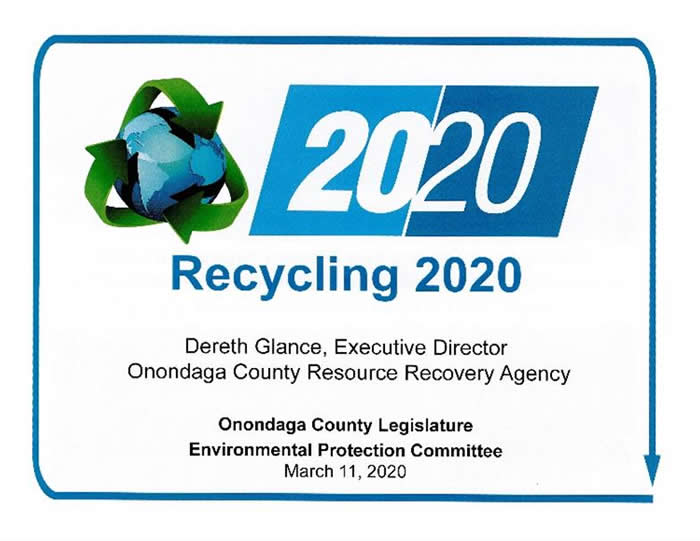
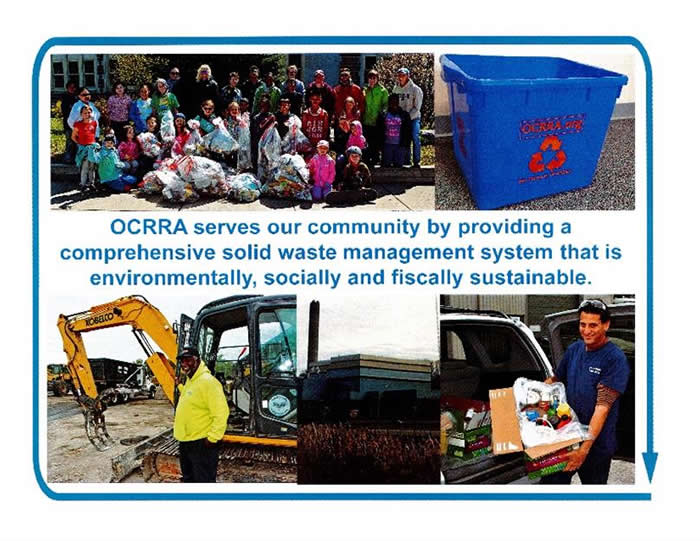

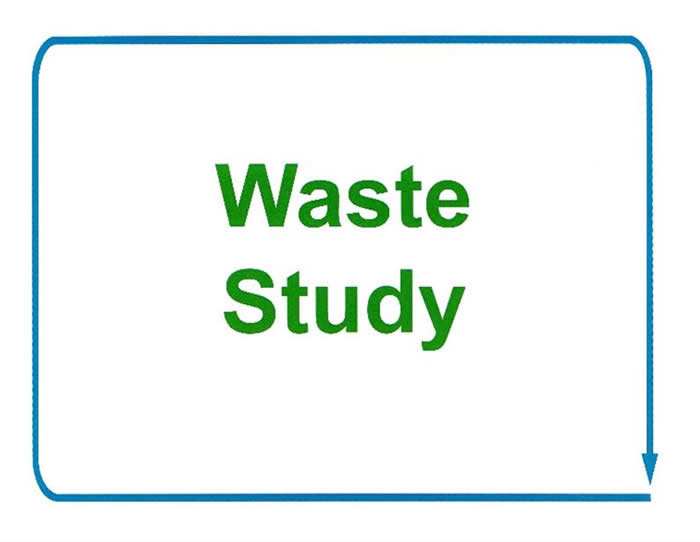
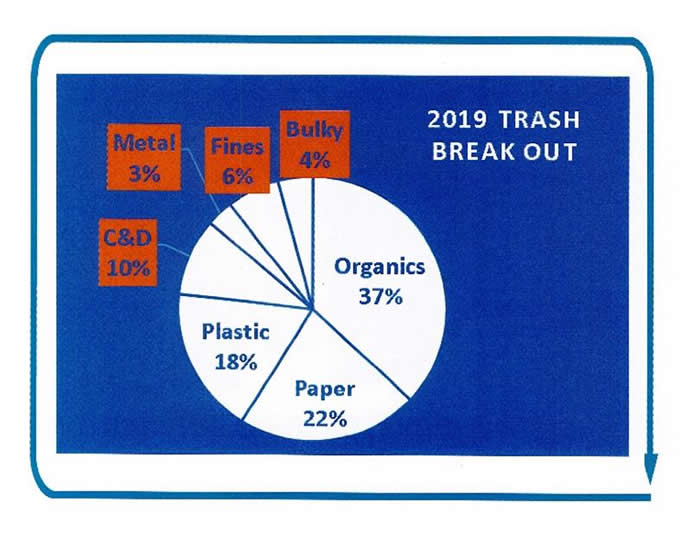
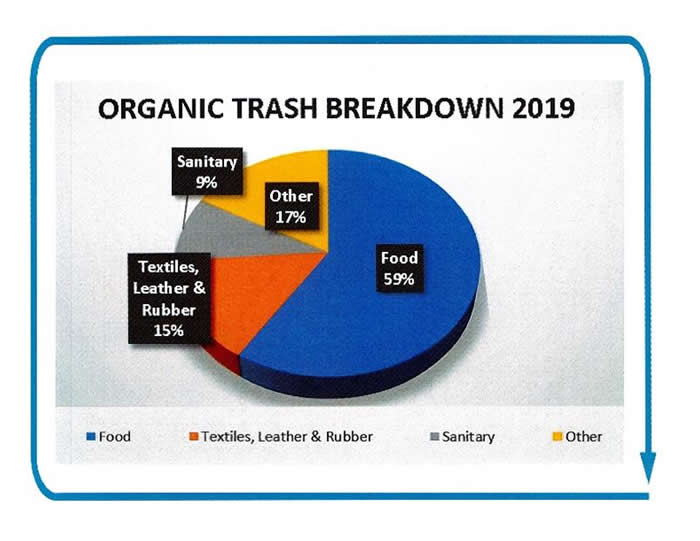
-
Want to be sure all understand what is in the garbage, the largest portion is organics, not stuff that they could compost, a significant portion of organics would be sanitary diapers - things that are garbage under any definition; looking to recover textiles and thin filmed plastics from the garbage, i.e. plastic around dry cleaning, paper towels, and toilet paper is recyclable if returned to the big box retailers, these are 2 key areas that they are focused on getting out of the garbage for additional waste reduction
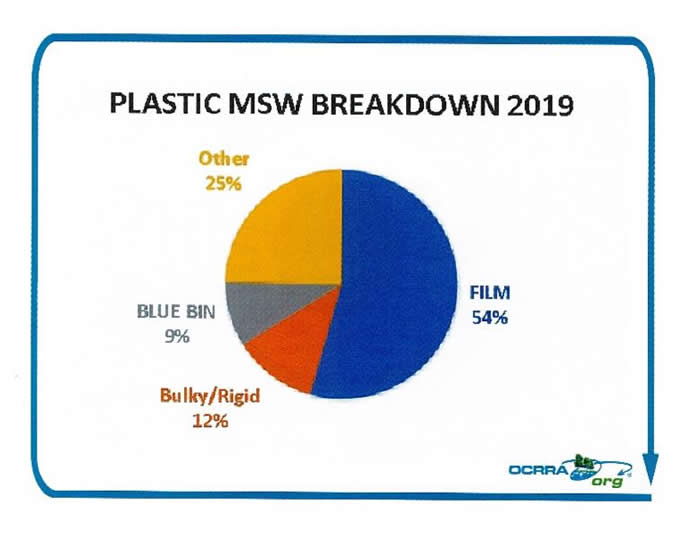 . .

- 56 million pounds of thin filmed plastics yearly in Onondaga County garbage
-
Over 50% of blue bin material is categorized as fiber, newspapers, magazines, mixed paper, and OCC or Kraft paper; fortunate to have large cardboard manufacture in the county that accepts the curbside cardboard; mixed paper and newspaper has changed dramatically, don’t have the outlet or demand, these are short fibers which have less strength and durability than cardboard, are working to get more local outlets; costs increased dramatically

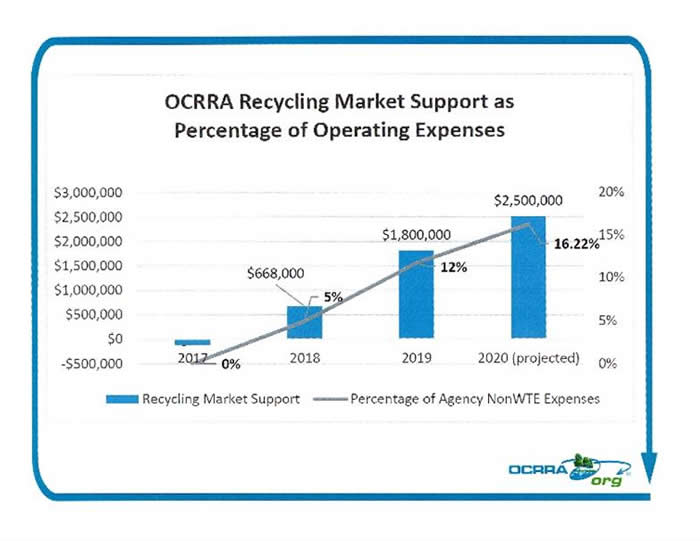
- From 2005 to 2017 the recycling expense was net-zero
-
2018 received a cancellation notice from the material recovery facility (MRF), contract with Waste Management Recycle America (WM), exposure was capped at $370,000, then the average blended value (ABV) of blue bin material fell below $40 per ton and trigger the cancellation, held the $370,000 cap until October of 2018 then had to pay a higher rate to keep the service
-
2019 renegotiated contract capped at $40 per ton, equaled 12% of their budget
-
Markets have not improved, more challenged, added $2.5 million in revised contract with WM to continue services as the status quo through 2020; able to do this and hold rates flat because the DEC helps support recycling education and outreach; previously received reimbursement grant for 3 years of work, never knew when it was coming so it was not built into their budget, 2019 was the last year for that big influx, now will be received each year, used those funds to offset this and paid off grant eligible equipment
-
Not sustainable; had a $6 increase in 2019, held flat for 2020
-
Model for 2021 is either put dollars on the tip fee to cover costs or look at how recycling is facilitated in this community; wrestling with some big changes as they move forward
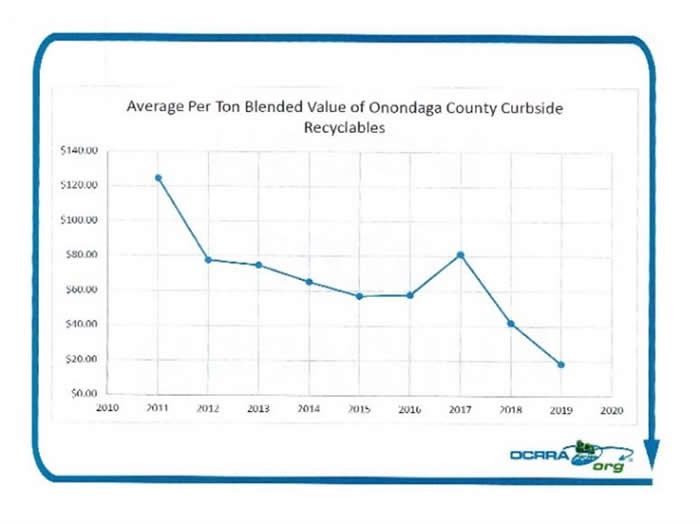 . .
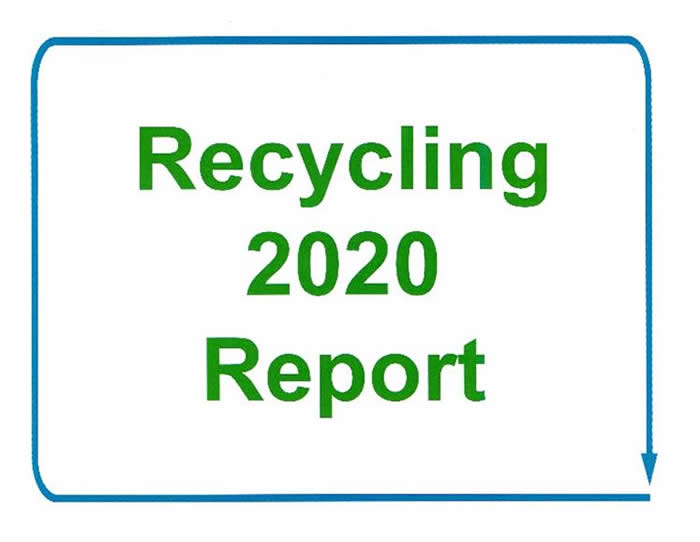
- Experts anticipate it will take 3 to 4 years to build the domestic capacity to absorb and provide better markets
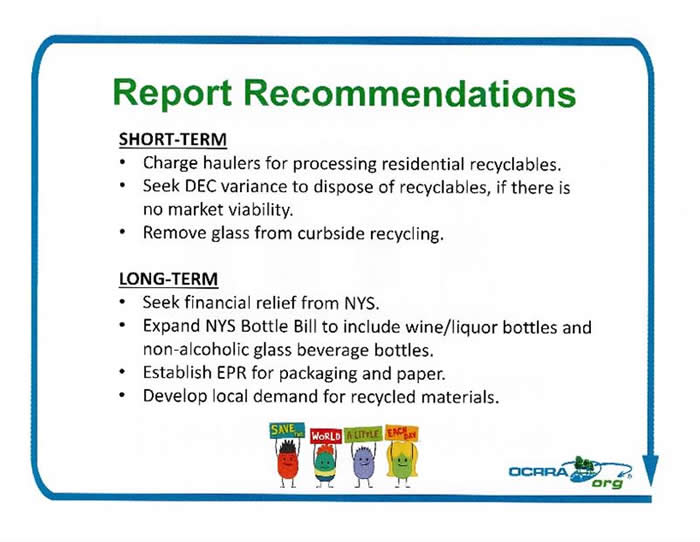 . .

-
Charging haulers for processing is a significant change of business, other cities do this but it is not the way our haulers have built their businesses; has several ramifications, not sure how quickly it could happen and what the consequences are for achieving the goals of the county’s source separation law
-
All recommendations are uncomfortable, need their input
-
Disposal fee is currently $91 per ton; cannot change rates in the middle of the year because of the contract model, the fee is set for 1 year; to limit the amount of exposure, agreed that if the mixed paper value is less than $35 per month for 3 consecutive months OCRRA will work with the DEC and WM to seek permit variations for alternate disposal
-
Need to expand the bottle bill to include wine and liquor bottles, would take 50% of the glass out of the blue bin and ensure the bottles are recycled into new bottles
- Quality reigns supreme, the cleaner the product the more markets to move it and the higher the price; glass is a contaminant to all other blue bin materials
Dr. Chase asked if the county could do this without the state. Ms. Glance responded that the bottle bill is a state policy and there is also a local county recycling law. In answer to Chairman Knapp, Mr. Glance confirmed that the county has some control over this as the local law specifies the mandatory recyclables. Chairman Jordan said that the question is does this have to be done at the state level. Mr. Yaus responded that he would look into this.
Ms. Glance said that one of the challenges is that wine and liquors have their own set of laws. Glass can always be recycled if collected further up the stream and the most effective way is using a bottle redemption program. Estimations are that this currently costs OCRRA $606,000 to process because they touch it so many times.
- The report has several appendixes; internal memo included talks about glass recycling alternatives, the financial estimate for the end of life use is listed on the last page (see pg. 16)
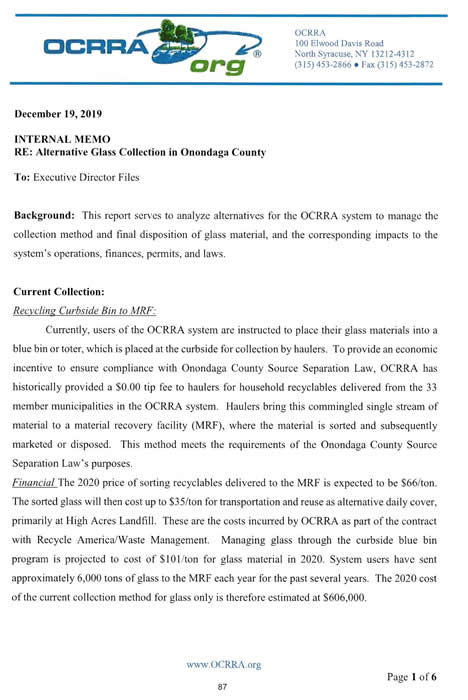 . .

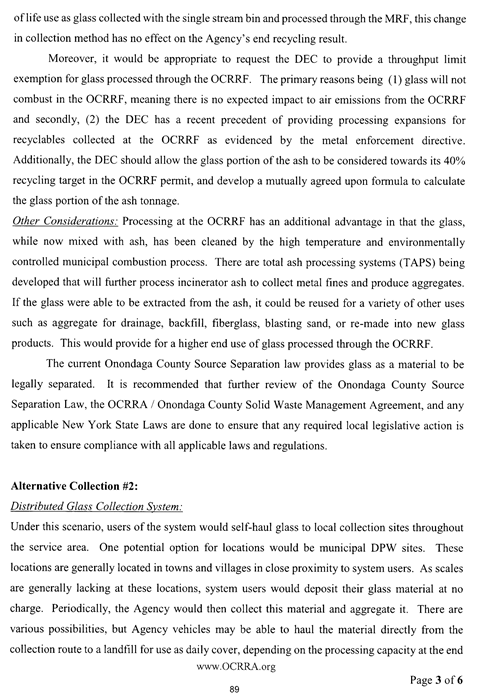 . .
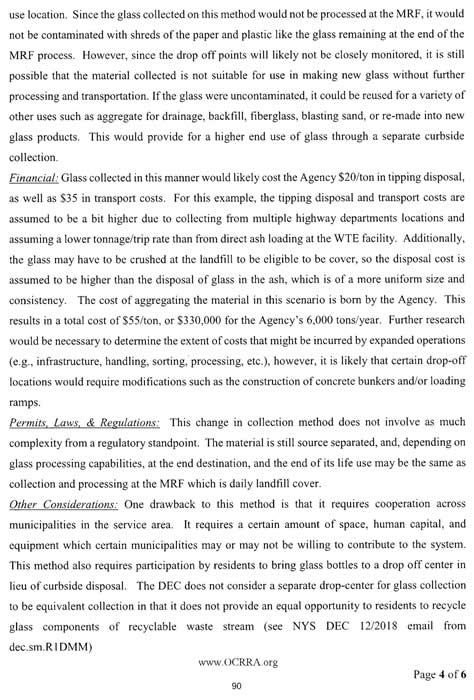
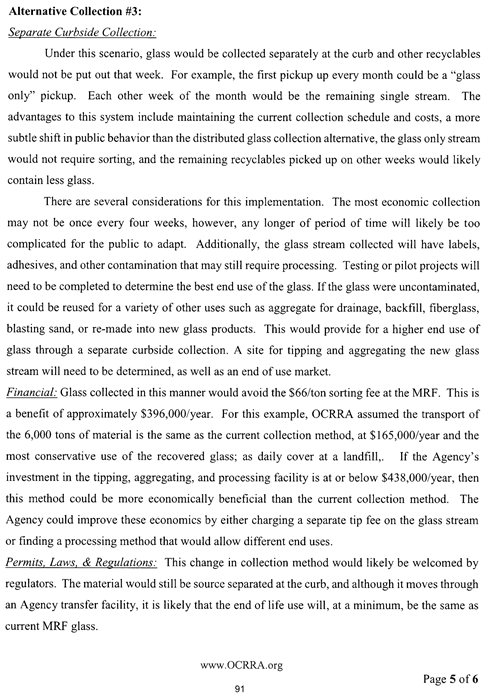

No one has the capacity to take all these recyclables and call them trash, nor do they want to; OCRRA avoids well over 1 million greenhouse gas emissions through recycling and the WTE facility
-
Direct financial relief from NYS would be helpful, processing and marketing is not currently supported
-
Important to promote industries that use these products and to use these products more locally; cardboard manufacturer in our county is critical and strategically placed, the county has amazing logistical access and supply warehouses coming in, keeping raw materials local and integrating economic development and retention would be really helpful
-
Currently have bills in the Senate and Assembly on Extended Producer Responsibility (EPR) for packaging and paper, brands would be responsible for the end of life; e-commerce is causing packaging to be more complex with mixed materials, more difficult to manage; working to shift responsibility to the manufacturer, more likely to solve the problem upstream
-
Need to change something, looking for feedback overtime; lots of other ways to manage this, other communities assess a fee to everyone
-
Focused on short-term - what is the most effective way to facilitate the goals for maintaining the incredible participation, ensuring the integrity of the system continues, and that evolve as products continue to evolve
Chairman Knapp commended Ms. Glance and her team for doing a tremendous job in a difficult environment.
In answer to Chairman Knapp, Ms. Glance said that they are doing a $12 million construction project at Rock Cut Road to comply with DEC regulations. They are a little behind the original time but have made significant progress. This facility will be enclosed with doors and have multiple load out sites so things will move through faster. Residents will continue to be served at Ley Creek for drop off and small commercial companies will be at Rock Cut Road once open later this year, as well as commercial haulers for large materials that need to be size reduced or managed differently than being directly dropped at the Covanta facility.
Chairman Knapp asked how they are doing with capacity at the steam plant. Ms. Glance responded that they are doing fine. Chairman Knapp asked if they were close. Ms. Glance responded that trash is seasonal. Right now it is low but they expect things to pick up; about 362,000 tons were processed last year at the WTE plant. They have a credit from the DEC because every ton of metal recovered from the WTE plant allows them to process more; had 9,000 tons of extra capacity. In answer to Chairman Knapp, Ms. Glance said that the official capacity is 361,350 tons plus credit for the metal processed. The biggest issue is the timing of garbage and the fiscal space of the pit; they can only get so many things in July when people are rocking construction projects. The material is managed well and a lot of C & D is bypassed to the Town of Camillus, i.e. hard fill and pressure-treated lumber.
Chairman Knapp encouraged anyone who hasn’t toured the WTE plant to do so. It is professionally run and there is no comparison to Seneca Meadows. Ms. Glance said that Seneca Meadows is set to close in 2025 and one of the great things about the WTE plant is that its capacity renews every year.
Chairman Knapp asked what they would have to do to bypass WM for part of the recycling stream, taking the product to local businesses for processing and reuse so that everybody wins. Ms. Glance responded that one of the big challenges has been that technology has advanced so fast in terms of recycling sorting. What was a state of the art MRF in 2017 is no longer at a time when these companies have no access to capital. They have been upside down on contracts and losing money because they cannot move the material. This is an interesting paradox and an interesting role for the government to come in. OCRRA is eligible for grants up to 50% but private companies are not. At best with a consolidated funding application, they might get up to 20%, often it is not worth going through the hoops to get that to happen. They have always focused on the markets being able to drive companies to make the investments needed. In an upside-down world, it is more challenging. They do not have a clear plan for how recyclables will be managed in the future. OCRRA has been working with WM, who has been working more with West Rock, to address these issues but it is all in flux.
Chairman Knapp said that OCRRA is very important because of their mission, and their debt and credit rating affects the county’s rating. Their success is important to us as a whole and that is also why they were asked to provide an update.
In answer to Dr. Chase, Ms. Glance said that composting is doing great. They have a partnership with Honeywell, who has been using a lot of the material for their rehabilitation projects on Onondaga Lake, as well as local landscapers and residents who use the compost and drop of products as well. The food waste is coming from Wegman’s, hospitals, Pastabilities and some restaurants. NYS adopted legislation in the 2019 budget that mandates source separation of organics for facilities with over 2 million pounds of organics. They won’t be able to deliver them to landfills directly. They will use aerobic digestion, composting, or some other type of technology to manage those. There is no problem getting material, it is making sure that they are operating at the right level to meet their objective in terms of moving that material for its end of life. They always encourage the county to be looking at ways where they can integrate the use of compost, i.e. DOT project or land disturbance. As long as there is a dedicated place for it to go they will make more. It is all the art of moving materials.
Mr. Copanas said that previously Chairman Knapp asked what he could do; removing glass from the recycle bin makes the paper more viable for West Rock. Ms. Glance said that it would be very helpful. Changing wine and liquor laws is a very big issue. Onondaga County can help add a profile to this issue by saying that they are going to do this. The state can help by expanding the bottle bill but until then this is what needs to happen.
a. Confirming Reappointment to the Onondaga County Resource Recovery Agency (Alberto Bianchetti)
A motion was made by Dr. Chase, seconded by Mr. Holmquist, to approve this item. Passed unanimously; MOTION CARRIED
Chairman Jordan adjourned the meeting at 1:36 p.m.
Respectfully submitted,

KATHERINE M. FRENCH, Deputy Clerk
Onondaga County Legislature
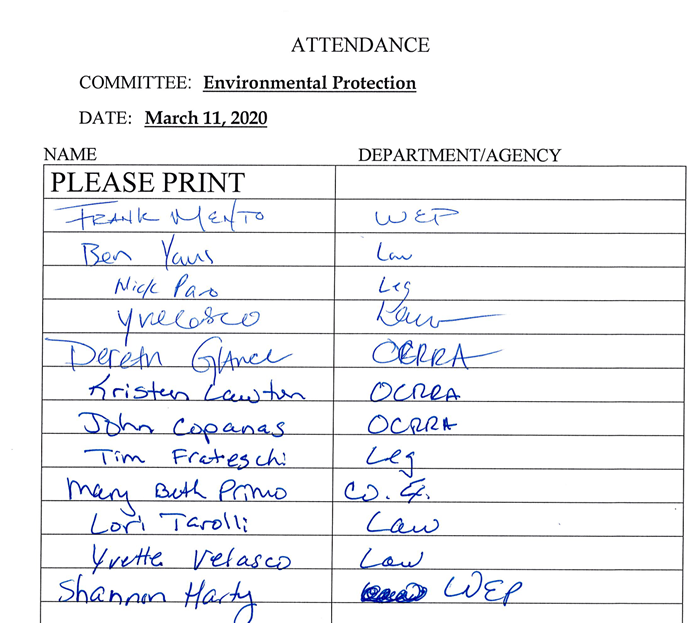
* * *
WAYS AND MEANS COMMITTEE MINUTES - March 30, 2020
VIRTUAL
TIM BURTIS, CHAIRMAN
AUDIO/VIDEO
MEMBERS PRESENT: Mr. Jordan, Mr. Williams, Mr. Ryan, Mr. May, Mr. Rowley, Mrs. Ervin
ALSO PRESENT: Chairman Knapp, Ms. Kuhn, Ms. Abbott-Keenan, Ms. Cody, Mr. Kinne, Dr. Chase, Ms. Lesniak, Mr. DeSantis, Mr. Durr, Mr. Yaus, Ms. Primo, Mr. Morgan, Mr. Donnelly, Mr. Mento, Mr. Glazier, Ms. McNamara, Mrs. Maturo
Chairman Burtis called the meeting to order at 9:35 a.m. A motion was made by Mr. Jordan, seconded by Mrs. Ervin, to waive the reading of the minutes of the proceedings of the previous committee. Passed unanimously; MOTION CARRIED. A motion was made by Mr. Jordan, seconded by Mrs. Ervin, to approve the minutes of the proceedings of the previous committee. Passed unanimously; MOTION CARRIED.
CONSENT AGENDA:
1. SHERIFF’S DEPARTMENT:
a. Amending the 2020 County Budget to Make Funds Available for Use by the Sheriff’s Office Within its STOP Violence Account ($249,989)
2. VETERANS SERVICE AGENCY:
a. A Local Law Amending the Onondaga County Charter and Administrative Code Regarding Veterans’ Services
b. Providing for Various Personnel Changes Related to the Reorganization of Adult Services and Amending the 2020 County Budget
3. TRANSPORTATION:
a. Authorizing an Intermunicipal Agreement with Oswego County for Bridge Repairs Associated with the Caughdenoy Road Bridge Over the Oneida River ($650,000)
A motion was made by Mr. Jordan, seconded by Mr. Rowley, to approve the items on the consent agenda. Passed unanimously; MOTION CARRIED.
REGULAR AGENDA
4. COMMISSION ON HUMAN RIGHTS: Brian Donnelly, Deputy County Executive
a. Confirming Appointment to the Onondaga County/Syracuse Commission on Human Rights (Rev. Baums)
Mr. Donnelly:
A motion was made by Mrs. Ervin, seconded by Mr. Williams, to approve this item. Passed unanimously; MOTION CARRIED.
Mrs. Ervin asked to be listed as a co-sponsor.
5. HEALTH DEPARTMENT: Brian Donnelly, Deputy County Executive
a. Personnel Resolution: Create 3 Medical Assistants, Grade 5 at $36,479 - $40,281; Abolish 3 Typist II, Grade 5 at $36,479 - $40,281
Mr. Donnelly:
- Budget neutral proposal
- Abolish 3 typist II’s; replacing them with Medical Assistants
- Long term will greatly help the Health Dept. in their clinics
- Short term – essential to the Covid-19 response
Mr. Rowley:
- Are these all Civil Service positions?
Mr. Donnelly:
- Yes and tested positions.
Mr. Rowley:
- Is a current list available now, or will these be appointed provisionally?
Mr. Donnelly:
- Do not know - would have to check if there is an existing list
Mr. Rowley:
- Will these be advertised for or is there someone in the pipeline?
Mr. Donnelly:
- Not sure; there are relatively stringent requirements for these positions. If there is a list, they will go off of that; if not, will look to the local health community to seek available candidates.
A motion was made by Mr. Jordan, seconded by Mr. Rowley. Passed unanimously; MOTION CARRIED.
6. WATER ENVIRONMENT PROTECTION: Frank Mento, Commissioner
a. A Resolution Approving the Proposed Leasing of Sewer Systems from Certain Municipalities within the Onondaga County Consolidated Sanitary District
Mr. Mento:
- Will discuss what has changed with respect to the lease since the last time discussed; no significant material changes, but a few minor items worth noting:
- Lease is materially the same in substance – still a 40 yr. lease with 4, 10 yr. continuous renewals
- Landlord and tenant obligations remain very much the same
- Two minor language additions
1. Section 3.2b – Provide debt relief up to $200k for various municipalities after their surplus is paid down
- Added an alternative provision – intended to support municipalities that don’t currently have any debt
- Opportunity for county to get involved and pay up to $200k for a green infrastructure project; that project will be performed by WEP and must be approved as it relates to a town, village, or hamlet center orientation
- It’s an either or: take $200k for debt relief after surplus is paid down or have opportunity to participate in a green infrastructure project
2. Minor comments from EFC, which strengthens county position to apply for funding with all of them – closes loopholes to make sure they are satisfied with county approach, which they are
- Key points:
- Phase 1 of consolidation is Meadowbrook Limestone and Meadowbrook Limestone service area
- WEP and law dept. have had several meetings with local municipalities in that area
- Town of Manlius & Village of Manlius are on board completely pursuant to their legal reviews – have passed resolutions
- Village of Fayetteville is very close – currently addressing one issue with them
- Had meetings scheduled with Towns of Dewitt and Pompey, but meetings have been postponed due to virus situation – will be reaching to them via telephone this week
Mr. May:
- What stage of the process is still in negotiation in Fayetteville?
M. Mento:
- It has to do with their offset position. The Village of Fayetteville established an offset program - for every gallon that was entered into the system, they took a gallon out, or make provisions to take a gallon out, so that they were running neutral in terms of capacity. They manage that system; we are working through some of the issues they feel are impacted – they feel they have certain rights to it.
- We are working out what our rights are so it doesn’t become an issue for them or anybody else.
Mr. May:
- Looking across the county do see this as something that will come up in other instances; how many other municipalities have the offset in process
Mr. Mento:
- A one or two situation – doesn’t see it as a big issue across the entire district
Mr. Rowley:
- In new section 3.2(b) – why does it have to be green infrastructure – i.e. if we have a bunch of properties along the river that are on septic, and we want to run a sewer line for houses to get hook up, why couldn’t we use this $200k towards that?
Mr. Mento:
- I think it was established that way because of the nature of the projects:
Mr. Mento read the language “it’s up to $200,000 in conjunction with a village main street, town center or hamlet development project.”
- I think most of those projects are not subsurface projects, not utility oriented – that’s why green infrastructure, porous pavement, sidewalk conditions, tree plantings, are to augment those categories of projects.
Ms. Primo:
- The idea was that the $200k on its own, can’t really do much in the sewer world, but if combined with the money that county, and perhaps state, would provide under a village main street program or town or village center hamlet program, it could make a significant contribution
- This gets to the heart of the problem we are having – it’s addressing I&I – not necessarily something we would be addressing in other types of projects
Mr. Rowley:
- There are projects in Clay where they wouldn’t necessarily be green per se, but have been on the table for a while now and that $200k helps.
Mr. Rowley:
- Under Section 4.1.2 – what does the word “control” mean in the context of this lease?
Mr. Rowley read Section 4.1.12 By virtue of this Lease, Landlord designates to Tenant and Tenant acquires, succeeds to and assumes the exclusive right, responsibility and authority to, inter alia, occupy operate, control, maintain, inspect, plan and use the Sewage Disposal System…”
Mr. Yaus:
- Your concerns are well received; we really tried to strike the appropriate balance.
- Control is a function of operate – you really need to be able to control in order to operate; a lot of these are synonyms to certain respect
- We are going to be managing these facilities and that’s part of the agreement
- We have tried to embody the cooperation of mutual agreements – coordinate on a plan, streets, right of ways, updating. It really is a cooperation and plan here.
- Our capacity determination is based on performance – that’s set forth in the lease – based on standard utility practices
- What EPA keeps telling us – we have a legal mandate to control sewer flow – they want us to put in flow meters...the idea of controlling flow, and the idea that the county might have to get more involved in that hands on is something we are working on with the EPA right now
- It is something that every municipality is having to deal with now in this landscape
- It’s something that just sort of had to happen; we need to be able to control it more , but we have defined it as whatever the municipality makes an application – we are basing it on standard capacity determination, as the municipality currently does, as WEP currently does, as municipalities and industries do across the nation
- If the town ever feels we are going beyond capacity, they have a lease remedy; we never think that is going to happen – we are really imagining a cooperative and collaborative process and this does provide for municipalities to be able to apply for extensions, new projects, and all of those determinations will solely be based on a capacity determination, as it currently is.
- Not much is changing from the way it currently is; in fact, little change at all from the way plans are currently reviewed
Mr. Frateschi:
- We have been trying to look at defined portions of the lease where we can show that it’s the same way that is it now – have talked with Mr. Yaus about this
- I am comfortable with Section 5.2, last sentence: Proposals for the expansion of or additions to the Sewage Disposal System initiated by Landlord may be implemented only after Tenant determines that the Sewage Disposal System and/or CSD Infrastructure has the capacity to accommodate the proposed expansion or addition.
- That’s really the situation as it exists today.
- We actually had that negotiated into the lease, or talked about putting something like that into the lease. That’s really the section we can point to that says that if capacity is an issue, you can’t expand; if it is not an issue, then you can expand.
Mr. Mento:
- Which by the way, is the current situation as well – there is not a material change or protocol that goes on between the town approval process and WEP approval process.
Ms. Primo:
- The way this decision will be made is basically how it is made now as far as future developments
- County cannot act arbitrarily and capriciously in denying developments when it has capacity
Mr. Jordan:
- I made it very clear over a year ago, that any proposal in terms of these leases had to recognize that certain municipalities have been shouldering their responsibility for maintaining the sewers within their district more than others, and there needs to be some recognition of that.
- I have raised this a number of times; I’ve raised this when it was first proposed a couple of months ago.
- Nevertheless, this lease agreement does the exact opposite – it actually benefits the municipalities that have not been investing in their infrastructure. It is more beneficial to them than it is to the ones that have been on top of, and maintaining, their infrastructure more.
- Have had this discussion with Mr. Mento and understands that we are under a consent order, but I have raised this a number of times – made it very clear as to what my position was long before proposal was even brought forward; made my position clear 2 months ago when the first draft of the lease agreement was prepared
- There has been more than enough time to address my objections/concerns, but they really haven’t been.
- I don’t think I can support this.
A motion was made by Mrs. Ervin, seconded by Mr. Ryan, to approve this item. AYES: 5 (Ryan, Williams, Ervin, May, Burtis); NOES: 1 (Jordan); ABSTENTIONS: 1 (Rowley). MOTION CARRIED.
b. A Local Law Authorizing the Lease of Sewage Disposal Systems from Certain Municipalities within the Onondaga County Consolidated Sanitary District for County Purposes
Mr. Mento:
- This memorializes the tenants of the lease as it relates to Meadowbrook Limestone.
- It’s a local law because it extends beyond the 5-year window.
- Part and parcel of the lease – has all of the major elements in it - provides in the local law to execute and enact
Mr. May:
- There has been a lot of progress and negotiation to get to this point.
- Commends Mr. Mento, Ms. Primo, Mr. Yaus, for driving this forward and trying to gain consensus on a very complex issue
- I don’t think it’s ever going to be perfect, and each situation is going to have its nuances.
- Agree with Legislator Jordan – it may not be fair for towns and villages that have done a really good job with their infrastructure, but consent orders are consent orders, and everybody will feel the pain including the rate payers in those areas
- Feels it’s time to move forward; this project is good to go almost; comfortable voting for it at this point
Mr. Jordan:
- Agrees we are under consent order, but there has been plenty of time to address the point I have been making for over a year now
- This disincentives municipalities that are looking at being consolidated or having the facilities leased down the road from investing in their infrastructure.
- Why would other towns, villages, be investing in their infrastructure – it’s actually going to be detrimental to them. They are better off ignoring it and investing their monies into other infrastructure projects, and ignoring the sewers, so by the time the county takes over the sewers they are going to be in worse shape than they would have been otherwise.
- This isn’t a tweaking issue; this is a major issue; it shouldn’t be a surprise to anyone – have been talking about this for a very long time
- Understands we are under consent order and it’s a very serious situation, this isn’t a new situation – we have known about this for a very long time and nothing has been done to really address my concerns
- Why is it that my concerns, and the points I have been making, have been completely ignored in any of this? This is the exact opposite of what I said would be a condition of my support, and exact opposite to addressing the issue that I have been talking about.
- I don’t think this is in the best interest of all of the rate payers because of the fact that it is going to incentivize municipalities to not invest in their infrastructure between now and the time the county leases their sewer system. I don’t think this is the best option.
- At one point it was proposed that the county would assume debt for municipalities that would eventually be consolidated with or had their systems leased. While that was an imperfect arrangement, that was something that was some recognition of the fact that not every municipality has been shouldering the responsibility to an equal extent. What was brought forward was not that; it was the exact opposite impact from the points I have been making.
- Not in the best interest of all of the all the rate payers; to say we have to enact on this now because we are under a consent order, is disingenuous because we have known about this for a long time, known about my objections for a long time
- There is no reason in the world why the points I have been making, the objections that I have had, could not have been address a long ago.
Mr. May:
- To be clear, I believe legislator Jordan is correct.
- Also want to point out that this is not just one legislators’ comments or concerns
- For the last year dating back to a different, but related topic, these conversations have been had, by leadership with the administration, with WEP. The bottom line is that they have been rejected out of hand – can site probably 3 different occasions
- That being said, the circumstances are what they are. Am I going to hold back on the small part of this that is wrong, or the bigger picture of this particular circumstance of just getting the work done – moving forward with something that overall, to most of us, makes sense once we get to the finish line of the whole project.
- In the meantime, I’ll join Legislator Jordan and say that there is a small disincentive until such time that the county is putting shovels in the ground to address other municipalities’ concerns, I think they are going to have trouble justifying making significant investments.
- It is what it is – how many more times can you ask and hear the answer “no”; it’s time to move forward.
A motion was made by Mr. May, seconded by Mrs. Ervin, to approve this item. AYES: 5 (Ryan, Williams, Ervin, May, Burtis); NOES: 1 (Jordan), ABSTENTIONS: 1 (Rowley). MOTION CARRIED.
7. ENVIRONMENT, OFFICE OF: Travis Glazier, Director
a. A Local Law Amending the 2004 Stipulated Judgment Between Honeywell International Inc. (Honeywell) and the County, Authorizing the Acquisition of Property and Lease of Two Parking Areas From Honeywell, and Authorizing the Execution of Agreements
Mr. Glazier:
- Onondaga Lake cleanup is 2 separate, distinct actions: Clean Water Act lawsuit by DEC against Onondaga County re: ACJ; Lawsuit by DEC under Comprehensive Environmental Response and Compensation Liability Act (CERCLA/Superfund) – DEC is suing Allied Signal, Honeywell’s predecessor
- At some time Allied Signal turned around and sued Onondaga County …(inaudible)
- County spent millions of dollars on technical experts and outside counsel defending itself against this action by Allied Signal against Onondaga County, a 2-party lawsuit, claiming the county contributed to the hazardous waste cleanup in Onondaga Lake
- Honeywell, who took over Allied Signal’s responsibility settled on an agreement – a stipulated judgment
- It is a very complicated, far reaching document, that really served the county well for over 16 years
- Both parties didn’t trust each other at the time; county didn’t trust Allied Signal and Honeywell came in and was relatively new, and the county had been fighting pretty hard against Honeywell and Allied Signal.
- The fact that they were able to come to this agreement was a big accomplishment.
- Important to keep in mind that this is between Onondaga County and Honeywell International; the part being discussed today is the remedial use fee
- Remedial use fees were intended to allow Onondaga County to birddog Honeywell and ensure that the cleanup process happen in a manner where the county had an opportunity to say how these properties were to be remediated.
- The language has a tremendous amount of ambiguity; it was clear that both the county and Honeywell did not agree with certain parts of the language – that’s where this change comes from
- Local law authorizes the county to accept 40 acres of land, referred to as the Lakeshore Property; enter into 2 leases: one long term lease for 10 years for approx. 20 acres of parking; another year-to-year lease for an additional 20 acres of property for as many as 10 years
- Also – a budget amendment to accept $625,000 from payment from Honeywell, adopted in 2020 budget for Loop the Lake related improvements
- We get the 40 acres of property, 2 leases for Willis Ave. parking area, which the county can use to offset amphitheater parking needs or generate revenue by allowing more State Fair parking, payment of $625K from Honeywell
- Honeywell received an extension of their remedial use fee suspension period for 10 years – those sites that haven’t met the qualifying steps at this time, have 10 years to meet those qualifying uses.
- Clarifies ambiguity within the agreement itself; ensures that both parties agree on which properties are subject to remedial use fee and what is a qualifying use to move the property from paying a remedial use fee to no longer being obligated to pay that fee
- The goal of remedial use fees was never to generate revenue for the county. Had there been a revenue generator for Onondaga County, it would have been really bad news for us because these properties would not be coming back into re-use.
- It was intended to be a hook in which Onondaga County could participate on the CERCLA side and ensure that Honeywell and DEC were looking out for the best interest of county taxpayers.
Mr. Jordan:
- Previous amendment to the stipulated judgment made reference to a payment of $950,000. Was that payment made, and if so, what were those monies used for?
Mr. Glazier:
- Payment was made; I don’t have the information in front of me – think they went to the general fund – suggested Ms. Primo may be able to answer
Ms. Primo:
- We did receive payment – don’t recall exactly where they went – deferred to Mr. Morgan
Mr. Morgan:
- I believe they went into the existing loop the lake project where these funds are going into
Mr. Jordan:
- Concerned that we are taking title to contaminated property and have concerns about future responsibilities
- Mr. Yaus has assured, and I saw it in the stipulated judgment, that Honeywell will indemnify us for any liabilities or actions brought relative to contamination on these sites – I am concerned about taking title that could change the whole dynamic
- Mr. Yaus made reference to the purchase agreement specifying that Honeywell continue to have a responsibility for any additional clean up or remediation necessary, but I haven’t seen that agreement yet – I again ask to get a copy of that purchase agreement and especially the provisions wherein Honeywell will remain liable for any additional clean up or remediation
- I ask for any documentation that specifically says that irrespective of the county taking title of the property that Honeywell would be solely responsible for any additional clean up or remediation on the parcels being conveyed to us
Mr. Yaus:
- Legislators will not have the purchase agreement before session – it’s going to be awhile to work out with Honeywell.
- It goes through the real estate folks; the lease as well – parking lot
- This local law sets forth the basic terms – have a lot of experience working with Honeywell on this, have talented real estate folks in the county law dept.; just did a recent property sale for a similarly contaminated property on the LCP site
- We are very familiar with this; this is how we have done these sort of arrangements in the past.
- Have laid out everything we are going to put in here – going to protect the county; that’s our goal
- Have circulated the consent order that binds Honeywell to do these sites; I mentioned the language that will be filed with the court that will make sure that they have access and outline their continued responsibility for the remedy; the stipulated judgment also provides indemnification
- In the normal CERCLA context you want to be careful about getting into title of property – that has not been a concern here – it is a remediated site
- The regulators are satisfied - had to have a PRP who is performing the remedy – not looking at anybody
- This is a unique scenario; protected on many different fronts – it will be in the purchase agreement as well
- We do not have a purchase agreement right now in draft.
Mr. Jordan:
- Why are we moving forward with this resolution if those details aren’t already worked out in writing; is there some reason that we have to do this now versus once we have the purchase agreement and lease agreements drafted and then bring it forward for a vote
Mr. Glazier:
- This is a federally …(inaudible)…document …; there is a process which after we put a document together, we are subject to ... (inaudible)…; the payment is due Dec. 31, 2020 for remedial use fees
- If this agreement isn’t in place prior to them, it could lead Onondaga County and Honeywell to have to resolve this in court
- Beginning this process with the legislature and empowering the county executive and county attorneys under terms outlined in the local law, to pursue getting the agreement altered in a way that the county doesn’t indemnify Honeywell of any of its responsibilities, as ordered under the consent order, and get these pieces in place so we can get documents finalized for eventual approval before Dec. 31, 2020, is really the key
- We are on a really tight timetable; there is a tremendous amount of pressure now to meet that timeline.
Mr. Jordan:
- Do we really anticipate it taking that long to get the agreement place? December 31st is a long ways away.
Mr. Yaus:
- Honeywell is extremely busy right now around the lake – they have numerous projects; the real estate folks are very busy.
- We looked at both of our schedules and it is going to take the parties some time. We are going to advance this as quickly as possible, but it has to go through the real estate folks and their vice president
- It follows a formal process – SEQRA has to be filed; certain things we need to do. It made sense to move it now with the upcoming date.
- It gets all of the parties into an understanding of how we are going to approach this going forward; we have a standard approach to approaching a purchase agreement like this with Honeywell
- The leases are not formed documents, but are industry documents
- It takes some time to draft them and go between, but are not expecting anything out of the ordinary here – have done this before
Mr. Jordan:
- The resolution makes no reference to the fact that Honeywell would remain liable for any cleanup or remediation on the property.
Mr. Yaus:
- I did not recite what we filed in the court; it will be clearly laid out in the court documents as well as the purchase agreement.
- All of that is set forth in the existing stipulated judgment and consent orders; those are existing orders as well.
Ms. Primo:
- We are going to put into the purchase offer a permission that would survive the purchase offer – they generally fall away once you have a deed.
- Will put in a provision that we are protected – this remedy is Honeywell’s; they are responsible for the remedy to continue; they are liable if it doesn’t
- Even if we didn’t put it in there, they are still responsible for the remedy and liable if it doesn’t based on federal and state laws.
- We are basically just adding another layer; it’s really not even necessary.
- “Ben, would you say that is correct?”
Mr. Yaus:
Mr. Ryan made a motion to approve this item.
Mr. May:
- We have talked about this; 99% makes sense to me, but this resolution is our work product.
- Have no doubt that the law will support Legislator Jordan’s concerns, and probably all of our concerns, that Honeywell will be responsible for future remediation, but it would be nice for our work product to have that language
- I’m going to ultimately end up abstaining – would like to see those words added in there – because this is the County Legislature’s work product and it should say what we would like it to say
- With that being said, it’s uncharacteristic for us to allow things like this to move on to session. In this case, if we could consider it considered; let it go, and have that slight adjustment made to the resolution, it would be better for all of us.
Mr. Yaus:
- Not sure, will have to check with Mrs. Tarolli, procedurally about altering a local law after local law day
- Understand that it doesn’t change the agreement or the nature of the local law, but completely understands why you would like that in there
- In hindsight, I probably should have added that in – will take that going forward as a noted to add that kind of language in
Mr. May seconded the motion. AYES: 4 (Ryan, William, Ervin, Burtis); NOES: 0; ABSTENTIONS: 3 (Jordan, Rowley, May). MOTION CARRIED.
Mr. May asked Mr. Yaus if between now and session he will be able to investigate whether that language can be added. Mr. Yaus agreed.
b. Amending the 2020 County Budget to Accept Funds Related to Amendments to the 2004 Stipulated Judgment Between Honeywell International Inc. and the County ($625,000)
Mr. Glazier:
- $625,000 payment to Onondaga County; accompanies the other part of the agreement (inaudible)
Mr. Rowley:
- Will we see that actual lease; will we have to approve that at some point, or does this local law take care of it?
Mr. Yaus:
- This local law authorizes us to do both – presumed to the terms of the local law; the only thing that might change is if Honeywell’s insurance goes up based on our use of the parking lot, or if taxes go up.
- Don’t really expect that; will be very minimal, but other than that it’s a pretty standard lease
- The answer is “no; it would not come back to you guys.”
Mr. May:
- Mr. Glazier, can you elaborate on the 3 parts? How does this resolution relate to what we just talked about in the prior resolution, or is it really a stand-alone thing?
Mr. Glazier:
- In amending the stipulated judgment, there is the exchange of a variety of pieces.
- One is this payment; this legislation authorizes the county to accept the payment for Loop the Lake Trails improvement
- The other pieces, outlined in the local law, are the acceptance of the property and the authorization for the county to enter into the two leases.
- It’s a negotiated agreement at this point.
- That’s 3 of the pieces of it, and there is the extension of the period to meet qualify uses under remedial use fees and the clarifying of… (inaudible)
Mr. May:
- This $625,000 has nothing to do with the lease of the parking areas, it’s independent of that but within the same agreement, correct?
Mr. Glazier:
Dr. Chase:
- Mr. Glazier said that the money was for the improvement of the loop the Lake – are there specific things related to what the plan for that is.
-
Chairman Burtis asked Mr. Glazier to get back to Dr. Chase regarding her question.
A motion was made by Mr. May, seconded by Mr. Ryan, to approve this item. AYES: 6; OPPOSED: 0; ABSTENTIONS: 1 (ROWLEY). MOTION CARRIED.
8. NAMING HONORABLE JAMES C. TORMEY, III CRIMINAL COURTS BUILDING:
a. Naming the Criminal Courts Building at 505 South State Street in Honor of the Honorable James C. Tormey, III, former Justice of the New York State Supreme Court
Mr. Donnelly:
- County Executive proposed this in his State of the County address
Mr. Jordan, Mrs. Ervin, Mr. May, Mr. Rowley, Mr. Burtis Mr. Kinne, and Dr. Chase asked to be listed as cosponsors to the resolution.
A motion was made by Mr. Jordan, seconded by Mrs. Ervin, to approve this item. Passed unanimously; MOTION CARRIED.
9. PERSONNEL:
a. Amending the Health Benefit Plan for Certain Retirees, Spouses and Dependents (Sponsored by Mr. Knapp)
Chair Knapp:
- The county executive presented this in his state of the county address – amazing how the world has changed since that address - we needed to do this then, but given the situation now, we really are going to need to do this now.
- This is part of a list of austerity measures that Mr. Morgan, the County Executive, and his team have been working on.
- It’s not just the retiree piece, a very important piece, it’s part of an overall plan.
- Not knowing what the state is doing with their budget – it’s not looking good for us from a Medicaid standpoint, and in several different areas
- Given our sales tax situation, this could be a truly very difficult year for us.
- Have talked to Leader May, the County Executive and his team several times – for session looking at making this part of the other pieces of the puzzle, in one resolution, to show the other things we are doing as well.
Mr. May:
- The world is in bad shape right now; our county and the people who live here are in bad shape
- The statistic read this morning is that 25% of the households have someone in there who is not working right now as a result of the virus.
- We tax for a lot of the money that we need to spent every year; we are largely funded, but there are some gigantic question marks as to what is going to happen with funding from on high during the year.
- We have all observed that people aren’t going anywhere; they aren’t buying gas; the gas they do buy is very low.
- This is probably the first round of austerity measures; the first of a few that are coming, and then will have a tough budget process on the heels of that.
- Look forward to seeing the package at session and recognize the urgency to which we are going to have to deal with some of this stuff
Mr. Jordan:
- Agrees with everything the County Executive and Mr. May have said
- This seems like a relatively small increase in the responsibility of the retirees, but then looked at the estimate of what the premiums would be for retirees and it is a 44% increase to the retiree, which is pretty significant.
- Having a little bit of a pause as to whether that is fair; it is pretty substantial.
- It seems like a small increase with 15% to 22%, but the actual numbers in terms of the impact upon the retiree is significant. A little hesitant in terms of the numbers
- In terms of shifting the responsibility or increasing the responsibility for the retiree – I don’t really have a problem with that; it’s really a question of what’s an appropriate increase in the responsibility. When you crunch the numbers, it seems a bit draconian.
Mr. May:
- One of the reasons behind my interest in seeing the whole package is that if everybody is hurting out in the real world and we are going to propose a measure like this, we better be thinking about a lot of ways that we will be making sacrifices before we ask people to absorb such an increase.
- I think we should have a plan and have a vision for how we are going to be impacted later in the year and into next year.
Mr. Jordan:
- Agrees, but we are talking about a transitory problem – the impact of the Corona Virus is going to be significant, but we are going to get beyond this.
- This isn’t a temporary measure where we are increasing it to 22% for a year or two years; this is going to be what they are going to have to be paying for the entire time after they retire.
- It’s a long term, permanent fix or solution to address a short term economic problem.
Mr. Ryan:
- Were the previous retirees locked in at 12%? Are they going to 22%?
Mr. Donnelly:
- This will not impact current retirees; this will not take effect until January 1, 2021, and only for individuals who retire at that point or after.
Mr. Jordan:
- It’s 15% to 22%, correct?
Mr. Donnelly:
Mr. Ryan:
- It’s anyone previously retired and locked in?
Mr. Donnelly:
- We are proposing for those that retire January 1, 2021 or later, that they will be paying 22, anyone before that will stay at their current rate.
- We are not proposing an increase for existing retirees or any retirees through the end for the year.
Mr. Ryan:
- This was tied into an incentive to get people to retire early.
Mr. Donnelly:
- This had been discussed along with an incentive; the incentive is not moving forward.
Mrs. Ervin:
- I have some concerns. If there is no incentive going forward, and this is quite an increase for some, I’m really concerned.
- We need to think about this a little bit longer; I’m not prepared to support it today.
Chair Burtis:
- We are not taking a vote on it today; we are just considering it.
10. ONONDAGA COUNTY PUBLIC LIBRARY:
a. Amending the 2020 County Budget to Make Funds Available in Connection with the Central Library Reconfiguration Project ($2,370,612)
Mr. Morgan:
- Amend 2020 budget, Galleries Lease Project, almost $2.4 million
- Forwarded a worksheet, sent out by the Clerk of the Legislature
- Project was originally established in November of 2014 at a level of $6,566,000 – it was put forward/approved to support the tenant fit out on floors 4 & 5 for Upstate
- It also supported the rent to the Galleries for the basement, space on floors 1 & 2 for library reconfiguration project
- It also provided funding for condominium unit charges and maintenance, repairs, cleaning services for that space
- March 2018 – amendment presented to this project, $4.3 million; that resolution was modified through the process and legislature approved $2.3 million – specifically to buy the square footage in the basement, and floors 1 & 2 for library configuration that we were previously leasing
- The additional money asked for, that was not approved, was to continue on with supporting the lease of floors 4 & 5 to Upstate
- It was mentioned that we would be back in 2019 to once again modify this project, but were able to get into 2020
- Have now run out of money so the ability to support the Upstate lease is now coming to an end without this approval - not new news
- Requesting $2.37 million – will cover condominium unit charges and maintenance, repairs, janitorial services through the first 10 years of Upstate lease, 2026
- Revenue side: projected through 2026 balance $3.5 million to the negative; will come back to the legislature some time in 2026 to address this project – hopefully extending the lease with Upstate or with a new partner
- Projections in terms of the project being paid back are in the 2033 – 2034 year
- No local dollars; revenues accumulate from the lease of floors 4 & 5 to Upstate
- Annual lease amount used to pay for these costs
- Project is upside down as a result of tenant fit out and the purchase price, which was transparent – we knew that was going to be the case
- The whole approach here was to spin up future revenues to support the reconfiguration of the library.
Mr. Rowley:
- Cash for the project comes out of the general fund, correct?
Mr. Morgan:
- Yes – we use pooled cashed to front the money here; as the lease amounts come in from Upstate, it is used to offset past and current expenses
Mr. Rowley:
- Can you define pooled cash – is it just general fund cash – you can’t co-mingle can you?
Mr. Morgan:
- Our pooled cash is county-wide cash; it can be used across all funds.
- WEP has fund balance of their own, but the cash is still in our pooled cash and we are able to tap into it and use it for any purpose
Mr. Rowley:
- What was pooled cash in the 2018 CAFR?
Mr. Morgan:
- I don’t know; right now we are in the $200 million range
Mr. Rowley:
- Do you know where we are going to be in 2019 when we close the books?
Mr. Morgan:
- I would assume in that same range; have a report from Jan. 2020 and we are around $214 million in cash
Mr. Rowley:
- Was against this project when we first approved it
- In this case, we are doubling down on a bad deal in my opinion
- Using Mr. Morgan’s forecast of when this project might come to fruition in terms of not being underwater, we are into the 2033-2034 year. I don’t know if that is right or not.
- Assuming this amount will last through 2026; they will come back in 2026 if, that a big “if”, we get a renewal of the lease and ask for more money, which will extend it possibly 2033 – 2034 year, depending on what things cost at that time.
- I guess we can do a spin up, but I question whether or not it was legal to begin with.
- Think this is doubling down on a very bad deal – given this situation, there is no way I can support this
- My suggestion to the county executive to make this right, is if he needed a small appropriation to get over the hump in terms of maintenance, I would be happy to entertain that.
- I think he needs to look at ROT, and reallocate ROT towards this project to get out from underneath it.
- I am not comfortable with this at all; will be voting “no.”
Mr. Morgan:
- ROT can’t be used in this case – it’s to promote tourism - you would have a stretch to say that the library operation is promoting tourism.
- “In case you haven’t noticed, the economy is in a tailspin. No one is staying in hotels. The ability to use ROT is nil.”
- We are going to be out there reducing ROT funded contracts, most likely.
- In terms of a little bit of maintenance – if we don’t have these dollars, we cannot maintain and service the lease with Upstate.
- So what happens then – Upstate leaves and it leaves this project completely under water with no future revenue potentially to come in, that at some point is going to have to be addressed
- In that situation, it would have to be pulled out of the general fund.
- I think you well know that going forward here, we are going to be in a rough patch financially.
- I appreciate your comments and concerns, but unfortunately at this point, we have to be good landlords to our tenant -- it’s necessary to have the spending authority for us to do that.
Mr. Rowley:
- I think you could make a case for ROT; we make a case for ROT for everything.
- You are right, ROT is not going to come back anytime soon, but I’ve got to believe it’s going to come back because if it doesn’t, we are in bigger trouble than I thought.
- I still think it’s a better solution than using pooled cash and driving this thing more negative with the hope that we are going to get a lease extension after 2026.
- We need to take another look at this and try to find funds in other places.
Mr. May:
- Way back after several of us got onto the legislature, I voted against the big moves at the library.
- Since that time, everything that has come up, I have felt there has been no choice but to support it…’in for a penny, in for a pound” situation.
- We knew this was coming when we kicked the can down the road a couple of years ago.
- I’ll be holding my nose in voting today--hoping we are getting near the end of the line with the large scale support being asked of as at the library.
- To Mr. Morgan’s point – we have rough patch coming, but I’m saying this without the rough patch – this has to slow down a little bit.
Mr. Jordan:
- I don’t think I supported the initial library renovation; didn’t support the purchase of the additional space
- Went to the library and there was an overabundance of unused space already in existence and found no reason whatsoever to buy additional space when unused spaces existed
- Right now looking at being under water unit 2034; projected out maintenance and repairs of $2.4 million now, but 14 years from now will be looking at facilities that are roughly 20 years old and will probably require quite a bit of upkeep and remodeling
- Seems like we are continuing to throw money down a hole - $11.3 million for this library where there is space that is unutilized now.
- Encourages the executive side to look at reconfiguring the space – we have wide open areas; seems we could make better use or economize on the space and reduce our costs by utilizing the space we have more efficiently.
- Maybe sell off some of the extra space, reconfigure to more appropriately utilize the space - use the space and maybe get rid of some of the space that we have and reduce our costs
Mrs. Ervin:
- It’s hard to look back and say we made a mistake; at this point what is your solution to this; what are you going to do with the extra space if you find some there?
- Bottom line--at this point in time, we have to do something to cover the maintenance for the tenant that is there right now; don’t think there is any choice in doing what is being asked of us to do right now
- It’s a matter of looking forward to doing something different before we get to 2026
Mr. Jordan:
- If we could reconfigure it, using less space, sell off some of our space, then we are reducing our costs
- Maybe our maintenance, repairs, janitorial costs, and overall costs could be reduced.
Mrs. Ervin:
- It wouldn’t be immediate, would it?
Mr. Jordan:
- No, but the $2.4 million isn’t immediate either – it’s between now and 2026
- The appropriation you are talking about is to get us through the end of the current lease, not just over the next year.
- If we are better utilizing our space, reducing costs, then maybe we don’t need $2.4 million to get us through the end of the lease term
A motion was made by Mrs. Ervin, seconded by Mr. Ryan, to approve this item. AYES: 5; NOES: 2 (Jordan, Rowley). MOTION CARRIED.
11. FINANCE: Steven Morgan, CFO
a. Memorializing New York State to Enact Legislation (A. 9992/S. 7998) in Relation to Extending the Authorization to Impose an Additional Rate of Sales and Compensating Use Taxes in Onondaga County, and Requesting and Concurring in the Preparation of a Home Rule Request
Mr. Morgan:
- Second step in getting our 1% extended for another 2 years
- Home Rule legislation – Assembly and Senate bills have been identified – will be forwarded onto the state for consideration
- With the situation we are in, the state is looking to address all of these, bundle them and vote on all of them at once
- Typical, historical process used to maintain the additional 1%
Chair Burtis:
- This is what the legislature has done every 2 years, but this one will run for 3 years.
Mr. Morgan:
- There is some confusion around it; it is potentially 3. If it’s not, we will come over during the right period of time.
- The last step will be a local law to enact the additional 1%, once the state legislature adopts legislation.
Chair Knapp:
- To make sure there is no misinterpretation, this is for our 1% sales tax that we have done every couple of years
- It has nothing to do with room occupancy tax – that’s a totally separate thing – we have already taken care of that
- Obviously, we are desperately going to need this money going forward.
A motion was made by Mr. May, seconded by Mrs. Ervin, to approve this item. Passed unanimously; MOTION CARRIED.
A motion was made by Mr. Jordan, seconded by Mrs. Ervin, to adjourn at 11:15 a.m. Passed unanimously; MOTION CARRIED.
The meeting was adjourned at 11:15 a.m.
Respectfully submitted,
DEBORAH L. MATURO, Clerk
Onondaga County Legislature
|













































